u blox Malmo 0965 WLAN and Bluetooth Module User Manual ODIN W2 series
u-blox Malmo AB WLAN and Bluetooth Module ODIN W2 series
user manual
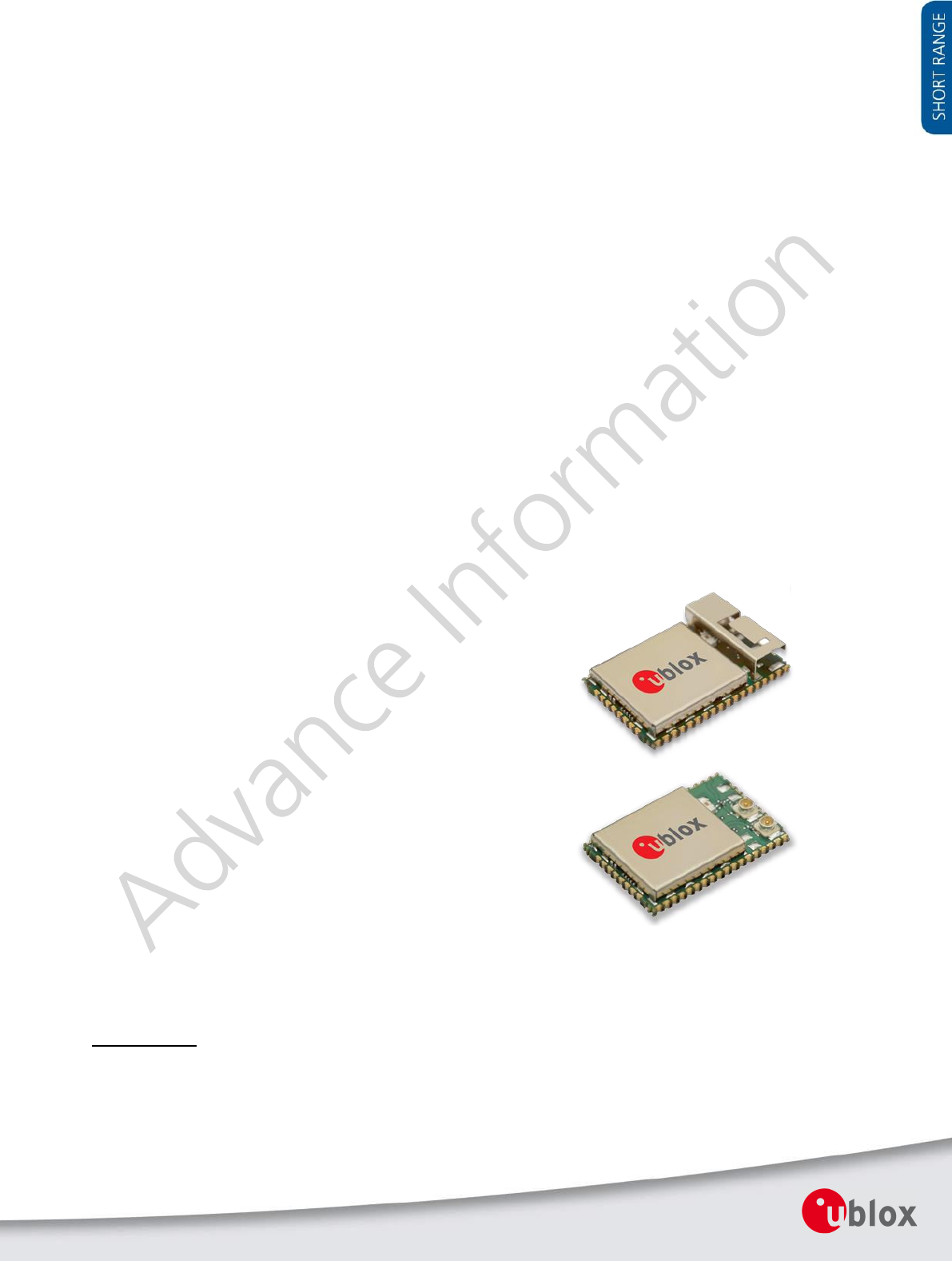
ODIN-W2 series
Stand-alone multiradio modules with
Wi-Fi & Bluetooth
Data Sheet
Abstract
This technical data sheet describes the ODIN-W2 series short range
multiradio modules with Wi-Fi and Bluetooth dual mode 4.0
(Classic Bluetooth and Bluetooth Low Energy). The ODIN-W2 is a
compact yet powerful stand-alone multiradio module designed for
Internet-of-Things applications in the compact ODIN form factor.
The Wi-Fi support conforms to IEEE 802.11a/b/g/n, and has support
for dual-band 2.4 GHz and 5 GHz operation and 2×2 MIMO (2.4
GHz).
www.u-blox.com
UBX-14039949 - R06

ODIN-W2 series - Data Sheet
UBX-14039949 - R06 Advance Information Contents
Page 2 of 44
Document Information
Title
ODIN-W2 series
Subtitle
Stand-alone multiradio modules with Wi-Fi & Bluetooth
Document type
Data Sheet
Document number
UBX-14039949
Revision and date
R06
09-Nov-2015
Document status
Advance Information
Document status explanation
Objective Specification
Document contains target values. Revised and supplementary data will be published later.
Advance Information
Document contains data based on early testing. Revised and supplementary data will be published later.
Early Production Information
Document contains data from product verification. Revised and supplementary data may be published later.
Production Information
Document contains the final product specification.
This document applies to the following products:
Product name
Type number
Firmware version
PCN / IN reference
ODIN-W260
ODIN-W260-00B-00
1.0.0
TBD
ODIN-W262
ODIN-W262-00B-00
1.0.0
TBD
u-blox reserves all rights to this document and the information contained herein. Products, names, logos and designs described herein may in
whole or in part be subject to intellectual property rights. Reproduction, use, modification or disclosure to third parties of this document or
any part thereof without the express permission of u-blox is strictly prohibited.
The information contained herein is provided “as is” and u-blox assumes no liability for the use of the information. No warranty, either
express or implied, is given, including but not limited, with respect to the accuracy, correctness, reliability and fitness for a particular purpose
of the information. This document may be revised by u-blox at any time. For most recent documents, visit www.u-blox.com.
Copyright © 2015, u-blox AG.
u-blox® is a registered trademark of u-blox Holding AG in the EU and other countries. ARM® is the registered trademark of ARM Limited in
the EU and other countries.

ODIN-W2 series - Data Sheet
UBX-14039949 - R06 Advance Information Contents
Page 3 of 44
Contents
Contents .............................................................................................................................. 3
1 Functional description .................................................................................................. 6
1.1 Overview .............................................................................................................................................. 6
1.2 Applications .......................................................................................................................................... 6
1.3 Product features ................................................................................................................................... 6
1.4 Block diagram ....................................................................................................................................... 7
1.5 Product description ............................................................................................................................... 7
1.6 AT command support ........................................................................................................................... 8
1.7 IEEE 802.11d and additional regulatory domains .................................................................................. 8
1.7.1 ODIN-W2 IEEE 802.11d implementation description ...................................................................... 8
2 Interfaces .................................................................................................................... 10
2.1 Power management ........................................................................................................................... 10
2.1.1 Module supply input (VCC) ......................................................................................................... 10
2.1.2 Digital I/O interfaces supply output (V_INT) .................................................................................. 10
2.2 Antenna interfaces ............................................................................................................................. 10
2.2.1 Antenna connectors and internal antenna ................................................................................... 11
2.3 Data communication interfaces .......................................................................................................... 12
2.3.1 UART interface ............................................................................................................................ 12
2.3.2 Ethernet interface ........................................................................................................................ 12
3 System functions ........................................................................................................ 13
3.1 Module power modes ........................................................................................................................ 13
3.2 Module reset ...................................................................................................................................... 13
3.3 System IO ........................................................................................................................................... 13
4 Pin definition .............................................................................................................. 14
4.1 Pin assignment ................................................................................................................................... 14
5 Electrical specifications .............................................................................................. 17
5.1 Absolute maximum ratings ................................................................................................................. 17
5.1.1 Maximum ESD ............................................................................................................................. 17
5.2 Operating conditions .......................................................................................................................... 17
5.2.1 Temperature range ...................................................................................................................... 17
5.2.2 Power supply ............................................................................................................................... 17
5.2.3 I/O DC characteristics .................................................................................................................. 18
5.2.4 Reset characteristics .................................................................................................................... 18
5.2.5 LPO clock .................................................................................................................................... 18
5.2.6 Universal asynchronous serial interface (UART) ............................................................................ 18
5.3 Current consumption.......................................................................................................................... 19
5.3.1 General current consumption ...................................................................................................... 19

ODIN-W2 series - Data Sheet
UBX-14039949 - R06 Advance Information Contents
Page 4 of 44
5.3.2 Current consumption Wi-Fi 2.4 GHz ............................................................................................ 19
5.3.3 Current consumption Wi-Fi 5 GHz ............................................................................................... 20
5.3.4 Current consumption Classic Bluetooth ....................................................................................... 20
5.3.5 Current consumption Bluetooth Low Energy (BLE) ....................................................................... 20
5.4 RF characteristics ................................................................................................................................ 21
5.4.1 Wi-Fi receiver characteristics 2.4 GHz .......................................................................................... 21
5.4.2 Wi-Fi receiver characteristics 5 GHz ............................................................................................. 21
5.4.3 Wi-Fi transmitter characteristics 2.4 GHz ..................................................................................... 22
5.4.4 Wi-Fi transmitter characteristics 5 GHz ........................................................................................ 22
5.4.5 Bluetooth classic receiver characteristics ...................................................................................... 22
5.4.6 Bluetooth Low Energy receiver sensitivity ..................................................................................... 23
5.4.7 Bluetooth Classic transmitter characteristics ................................................................................ 23
5.4.8 Bluetooth Low Energy transmitter characteristics ......................................................................... 23
6 Mechanical specifications .......................................................................................... 24
6.1 Dimensions ......................................................................................................................................... 24
6.2 Module weight ................................................................................................................................... 25
7 Qualification and approvals ...................................................................................... 26
7.1 Compliance with RoHS directive ......................................................................................................... 26
7.2 Declaration of Conformity .................................................................................................................. 27
7.3 Safety Compliance .............................................................................................................................. 28
7.4 FCC and IC Compliance ...................................................................................................................... 29
7.4.1 IC compliance.............................................................................................................................. 29
7.4.2 Conformité aux normes d’IC ....................................................................................................... 29
7.4.3 FCC statement ............................................................................................................................ 30
7.4.4 Labeling Requirements for End Product ....................................................................................... 31
7.5 Japan Radio Equipment Compliance ................................................................................................... 32
7.6 Bluetooth qualification information .................................................................................................... 32
8 Antennas ..................................................................................................................... 34
Antenna accessories................................................................................................................................... 34
Approved antennas.................................................................................................................................... 35
9 Product handling and soldering ................................................................................ 38
9.1 Packaging ........................................................................................................................................... 38
9.1.1 Reels ........................................................................................................................................... 38
9.1.2 Tapes .......................................................................................................................................... 38
9.2 Moisture sensitivity levels .................................................................................................................... 39
9.3 Reflow soldering ................................................................................................................................. 39
9.4 ESD precautions .................................................................................................................................. 39
10 Labeling and ordering information ........................................................................... 40
10.1 Product labeling .............................................................................................................................. 40
10.2 Explanation of codes ....................................................................................................................... 41

ODIN-W2 series - Data Sheet
UBX-14039949 - R06 Advance Information Contents
Page 5 of 44
10.3 Ordering information ...................................................................................................................... 41
Appendix .......................................................................................................................... 42
A Glossary ...................................................................................................................... 42
Related documents........................................................................................................... 43
Revision history ................................................................................................................ 43
Contact .............................................................................................................................. 44
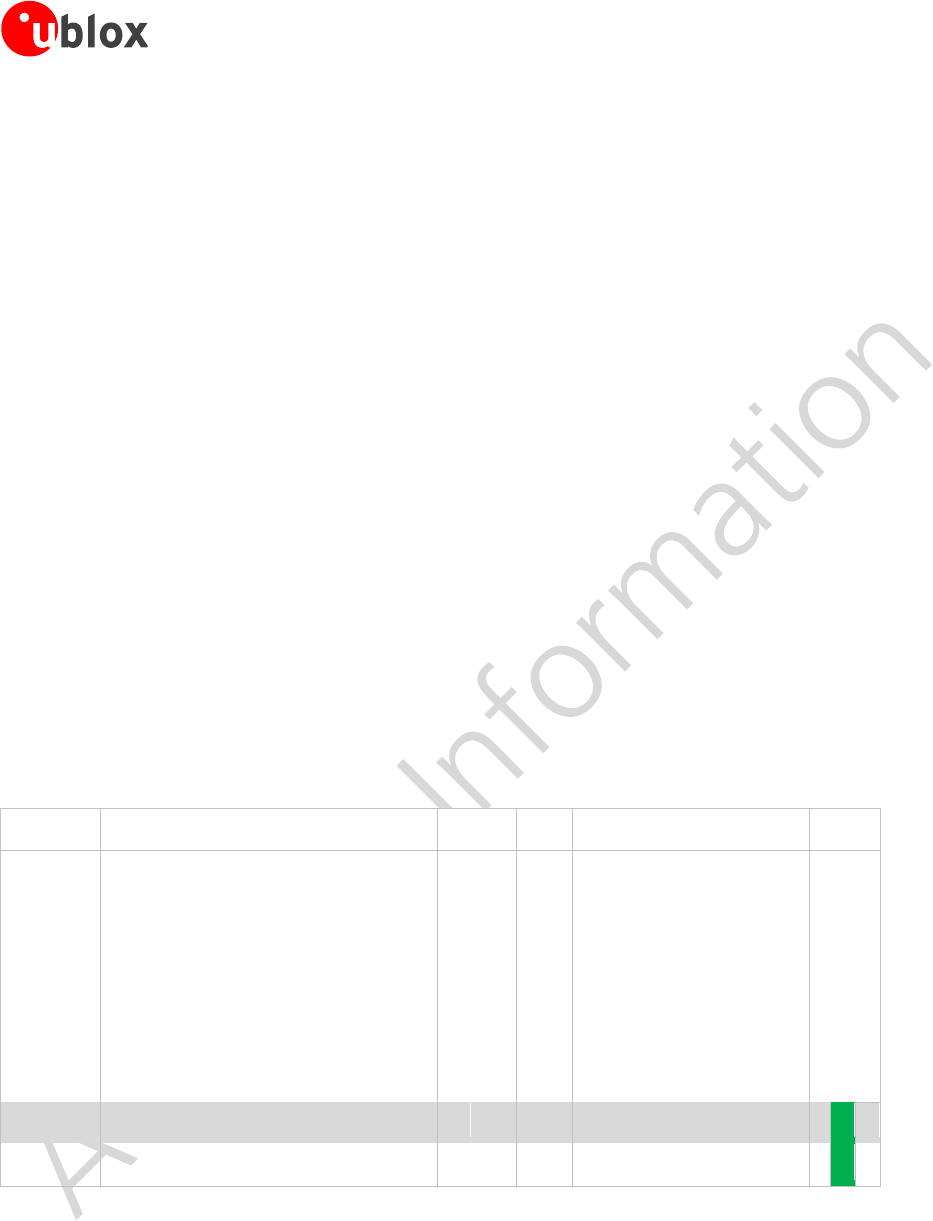
ODIN-W2 series - Data Sheet
UBX-14039949 - R06 Advance Information Functional description
Page 6 of 44
1 Functional description
1.1 Overview
The ODIN-W2 series is a highly integrated multiradio module from u-blox and the module has been developed
for integration in devices for demanding applications such as industrial and medical applications. The module is
built around a multiradio chip, which includes Wi-Fi, Classic Bluetooth and Bluetooth Low Energy (Dual Mode /
Bluetooth Smart Ready). The Wi-Fi support conforms to IEEE 802.11a/b/g/n, and has support for dual-band 2.4
GHz and 5 GHz operation and 2.4 GHz 2×2 MIMO.
The ODIN-W2 series module is developed for reliable, high demanding industrial devices and applications and
delivers high performance. The ODIN-W2 module is available in different versions (see Product features). The
module has a small form factor and the interface layout is the same as previous Bluetooth and Wi-Fi modules
from u-blox in the 15x22 mm ODIN form factor.
The module is complete with embedded driver, stack and application for wireless data transfer and AT-command
configuration.
1.2 Applications
Internet of Things (IoT)
Wi-Fi and Bluetooth networks
Medical and industrial networking
Access to laptops, mobile phones, and similar consumer devices
Home/building automation
Ethernet/Wireless Gateway
1.3 Product features
Model
Radio
Interfaces
Power
Features
Grade
Bluetooth qualification
Bluetooth profiles
Low Energy Serial Port Service
Wi-Fi IEEE 802.11a/b/g/n***
Max output power incl. antenna
Max range, in meters
2.4 GHz channels 1-13*
5 GHz channels 36-165*
Antenna type
UART
RMII**
Power supply: 3.0 - 3.6 V
Bluetooth throughput (Mbit/s)
Wi-Fi throughput (Mbit/s)
AT command support
Extended Data Mode protocol
Android connectivity
iOS connectivity
Wi-Fi Security
Standard
Professional
Automotive
ODIN-W260
4.0
SDPG
•
•
19 dBm
TBD
•
•
E
•
•
•
1.3
TBD
•
•
•
W/LE
Sec
ODIN-W262
4.0
SDPG
•
•
16 dBm
TBD
•
•
I
•
•
•
1.3
TBD
•
•
•
W/LE
Sec
S = SPP P = PAN*** E = U.FL connector(s) for external antenna
D = DUN G = GATT** I = Internal antenna
Sec = WPA2, Enterprise, EAP-TLS*** LE = Bluetooth Low Energy W = WLAN / Wi-Fi
* = Depends on region.
** = Planned for version ODIN-W26x-01B-00
*** = Planned feature.
Table 1: Key features of ODIN-W2 series
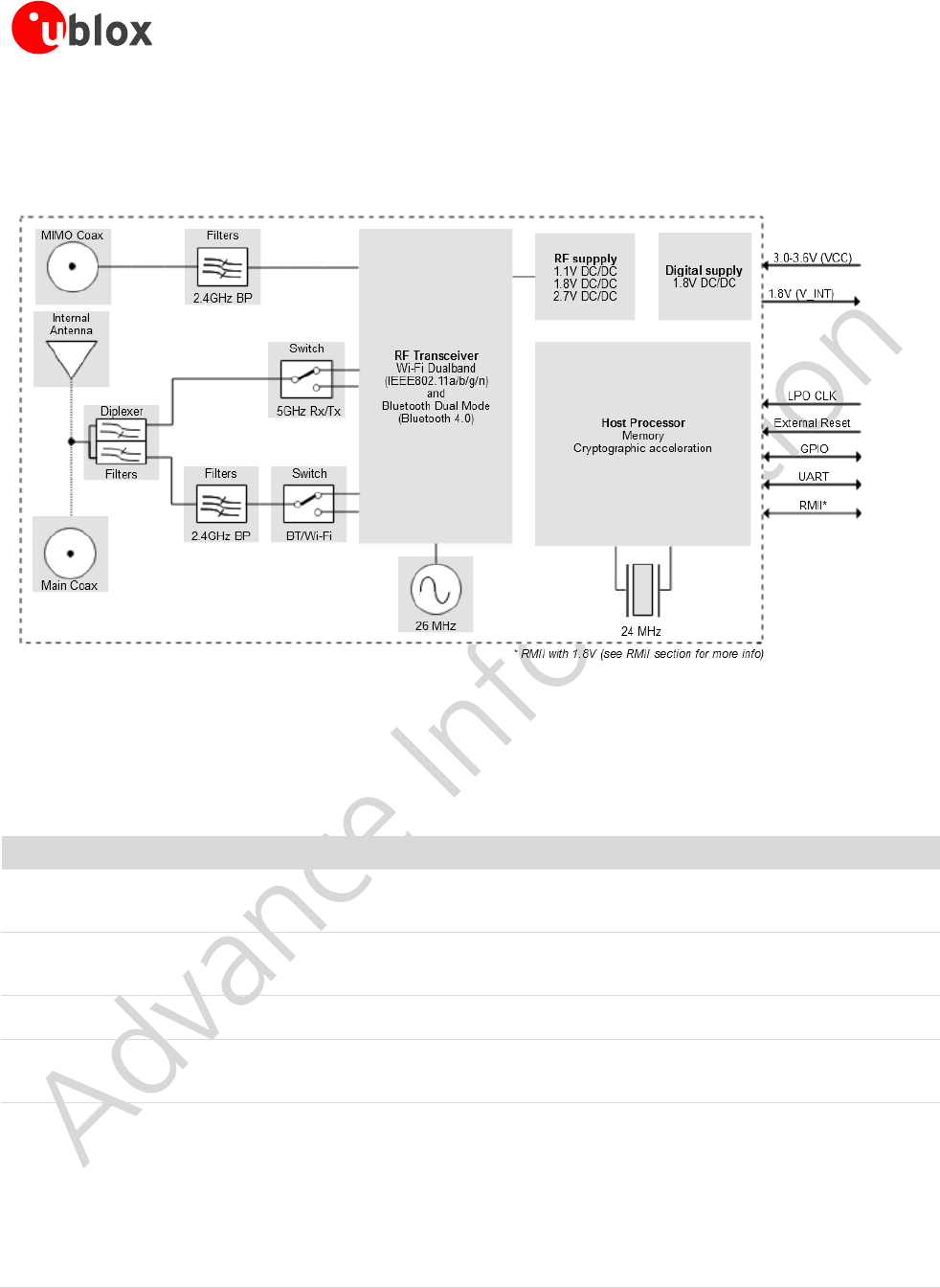
ODIN-W2 series - Data Sheet
UBX-14039949 - R06 Advance Information Functional description
Page 7 of 44
1.4 Block diagram
The block diagram of the ODIN-W2 series is shown below:
Figure 1: Block diagram of ODIN-W2 series
1.5 Product description
The ODIN-W2 series module supports Wi-Fi, classic Bluetooth and Bluetooth Low Energy (dual mode / Bluetooth
Smart Ready). The Wi-Fi support conforms to IEEE 802.11a/b/g/n, and has support for dual-band 2.4 GHz and 5
GHz operation and 2×2 MIMO (2.4 GHz).
Wi-Fi
Classic Bluetooth
Bluetooth Low Energy
IEEE 802.11a/b/g/n***
ODIN-W260: 2X2 MIMO***(2.4GHz only)
Bluetooth 4.0, Classic Bluetooth +EDR
Maximum number of slaves: 7
Bluetooth profiles: SPP, DUN, GATT and PAN
Bluetooth 4.0 BLE dual mode
Band support
2.4 GHz, channel 1-13*
5 GHz, channel 36-165*
Band support
2.4 GHz, 79 channels
Band support
2.4 GHz, 40 channels
Maximum conducted output power
16 dBm / 19 dBm EIRP**
Maximum conducted output power
11 dBm / 14 dBm EIRP**
Maximum conducted output power
6.5 dBm / 9.5 dBm EIRP**
Conducted sensitivity
2.4 GHz: -94 dBm / -97 dBm EIRP**
5 GHz: -88 dBm / -91 dBm EIRP**
Conducted sensitivity
-90 dBm / -93 dBm EIRP**
Conducted sensitivity
-94 dBm / -97 dBm EIRP**
Data rates:
IEEE 802.11b:
1 / 2 / 5.5 / 11 Mbit/s
IEEE 802.11a/g:
6 / 9 / 12 / 18 / 24 / 36 / 48 / 54 Mbit/s
IEEE 802.11n SISO***:
6.5 / 13 / 19.5 / 26 / 39 / 52 / 58.5 / 65 Mbit/s
IEEE 802.11n 2x2 MIMO***:
13 / 26 / 39 / 52 / 78 / 104 / 117 / 130 Mbit/s
Data rates:
1 / 2 / 3 Mbit/s
Data rates:
1 Mbit/s
* Maximum, supports 802.11d and depends on region.
** RF power including max antenna gain (3 dBi).
*** Planned feature.
Table 2: ODIN-W2 series Wi-Fi and Bluetooth characteristics
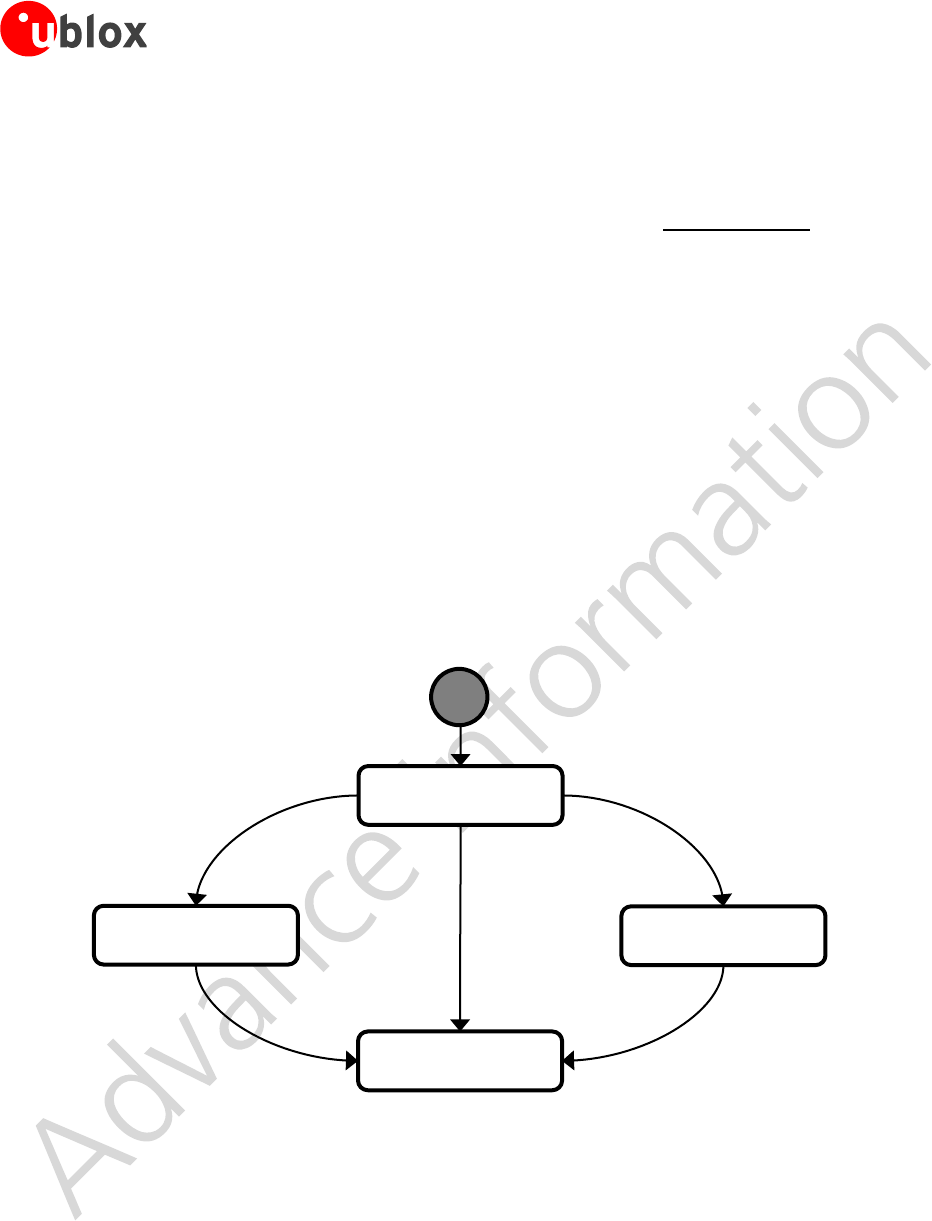
ODIN-W2 series - Data Sheet
UBX-14039949 - R06 Advance Information Functional description
Page 8 of 44
1.6 AT command support
The ODIN-W2 series modules support AT commands as mentioned in the ODIN-W2 AT Commands Manual [2].
See also the s-center software which is an easy to use tool from u-blox for evaluating, and configuration of u-
blox Short Range modules. The s-center tool is available for download on the www.u-blox.com website.
1.7 IEEE 802.11d and additional regulatory domains
The ODIN-W2 series module support IEEE 802.11d. IEEE 802.11d is an amendment to the IEEE 802.11
specification that adds support for "additional regulatory domains". IEEE 802.11d allows ODIN-W2 based
devices to self-configure and operate according to the regulations of its operating country and includes
parameters like country name, channel quantity and maximum transmission level. The country information
elements simplifies the creation of 802.11 wireless access points and client devices that meet the different
regulations enforced in various parts of the world.
1.7.1 ODIN-W2 IEEE 802.11d implementation description
When ODIN-W2 is used as a Wi-Fi station the scan is used to detect which regulatory domain it is currently in.
Passive scan is used for channels that are not available in all regulatory domains. The device supports three
domains: WORLD, FCC and ETSI where WORLD is the considered all channels that are supported both by FCC,
ETSI and most other countries in the world. See Table 3 for which channels are supported in the different
regulatory domains. The state transition diagram Figure 2 below describes the algorithm for selecting the current
regulatory domain.
Figure 2: ODIN-W2 series IEEE 802.11d state transition diagram.
Initial regulatory domain is WORLD. At start up a scan is initiated to detect beacons containing country
information IEs.
If at least one scan result contains country information indicating FCC and no country information indicates ETSI
the regulatory domain is set to FCC.
If at least three scan results contain country information indicating ETSI and no country information indicates
FCC then the regulatory domain is set to ETSI.
If the scan result contains country information indicating both FCC and country information indicating ETSI then
the regulatory domain is set to WORLD. In the state transition diagram this is the state WORLD_FINAL. This state
will not be exited until the device is reset.
WORLD
FCC
WORLD-FINAL
ETSI
Scan complete
FCC AP found and no ETSI AP found
Scan complete
ETSI found
Scan complete
Three or more ETSI AP found and
no FCC AP found
Scan complete
FCC found
Scan complete
No or both FCC and
ETSI AP found
Entry start scan
Do start scan every hour
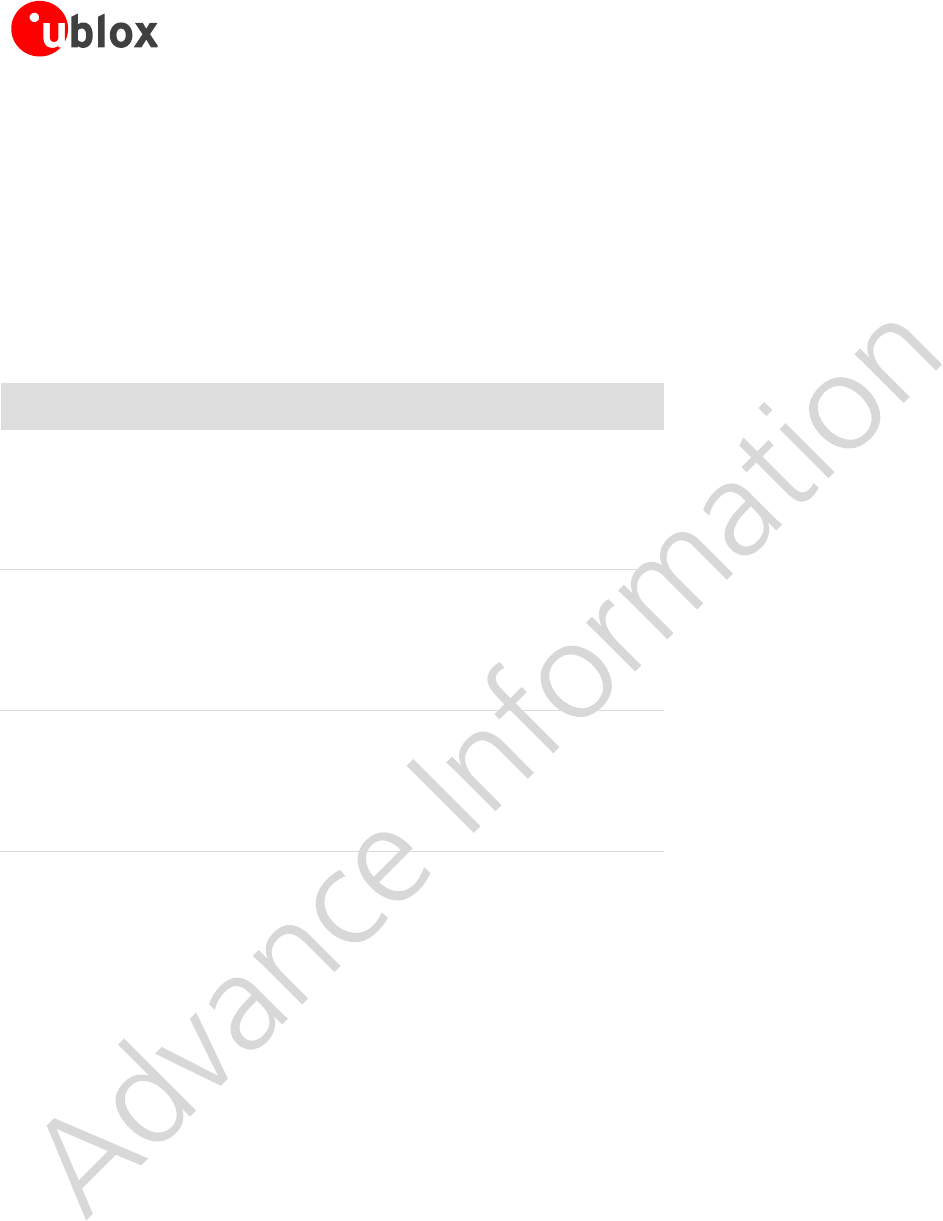
ODIN-W2 series - Data Sheet
UBX-14039949 - R06 Advance Information
Page 9 of 44
A new scan is performed every hour to update the regulatory domain.
If the current regulatory domain is ETSI and at least one scan result contains country information indicating FCC
and then the regulatory domain is set to WORLD. In the state transition diagram this is the state WORLD-FINAL.
This state is will not be exited until the device is reset.
If the current regulatory domain is FCC and at least one scan result contains country information indicating ETSI
and then the regulatory domain is set to WORLD. In the state transition diagram this is the state WORLD-FINAL.
This state is will not be exited until the device is reset.
At restart of the device the algorithm is restarted.
It is not possible to override the algorithm described by reconfiguration the device.
Regulatory
Domain
Band
Tx Channels
WORLD
2.4 GHz
1, 2, 3, 4, 5, 6, 7, 8, 9, 10, 11
U-NII-1
36, 40, 44, 48
U-NII-2
52, 56, 60, 64
U-NII-2e
100, 104, 108, 112, 116, 132, 136, 140
U-NII-3
-
ETSI
2.4 GHz
1, 2, 3, 4, 5, 6, 7, 8, 9, 10, 11, 12, 13
U-NII-1
36, 40, 44, 48
U-NII-2
52, 56, 60, 64
U-NII-2e
100, 104, 108, 112, 116, 120, 124, 128, 132, 136, 140
U-NII-3
149, 153, 157, 161, 165
FCC
2.4 GHz
1, 2, 3, 4, 5, 6, 7, 8, 9, 10, 11
U-NII-1
36, 40, 44, 48
U-NII-2
52, 56, 60, 64
U-NII-2e
100, 104, 108, 112, 116, 132, 136, 140
U-NII-3
149, 153, 157, 161, 165
Table 3: Channel list for supported regulatory domains. The max output power is reduced on some channels depending on
regulatory requirements (e.g. can frequency band edge requirements limit the output power on channels close to band edges).
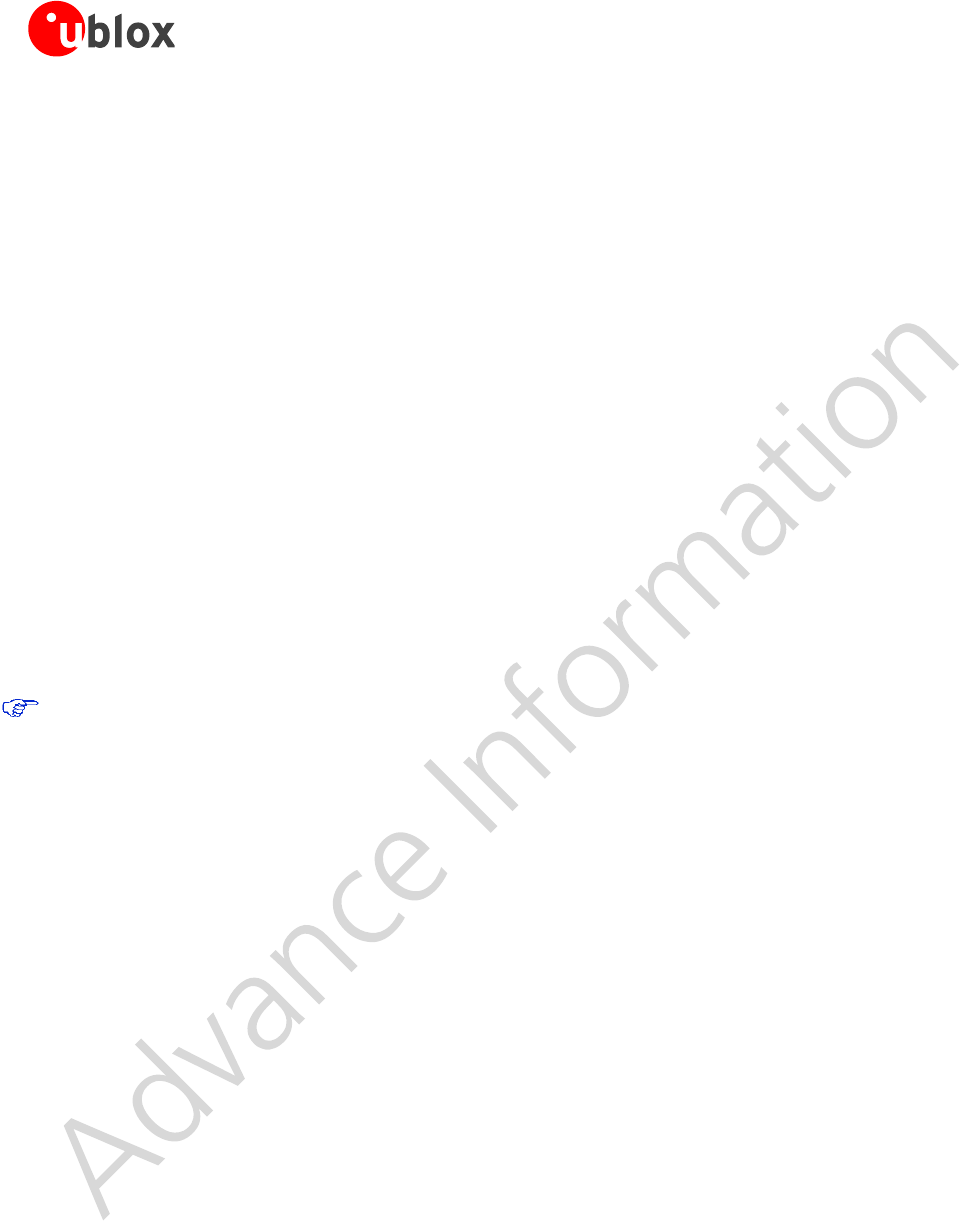
ODIN-W2 series - Data Sheet
UBX-14039949 - R06 Advance Information Interfaces
Page 10 of 44
2 Interfaces
2.1 Power management
2.1.1 Module supply input (VCC)
The ODIN-W2 series modules must be supplied through the VCC pin by a DC power supply. Voltage must be
stable as during operation the current drawn from VCC can vary significantly based on the power consumption
profile of the Bluetooth/Wi-Fi technologies.
2.1.2 Digital I/O interfaces supply output (V_INT)
The ODIN-W2 series modules provide a 1.8 V supply rail output on the V_INT pin, which is internally generated
when the module is powered on. The same voltage domain is used internally to supply the generic digital
interfaces of the modules. The V_INT supply output can be used instead of an external discrete regulator. See
the Electrical specifications section for maximum output current.
2.2 Antenna interfaces
The following two different antenna options are available in the ODIN-W2 series:
ODIN-W260 equipped with dual U.FL. coaxial connectors for external antennas. Different types of
external antennas are available and can be used.
ODIN-W262 equipped with an integrated dual-band antenna
While mounting the unit, ensure that it does not interfere with radio communication. The ODIN-W262
equipped with an internal surface mounted antenna should not be mounted in a metal enclosure. No
metal casing or plastics using metal flakes should be used. Avoid metallic based paint or lacquer.
See Antennas chapter for information on the external antennas that can be used and for other RF and antenna
design advices.
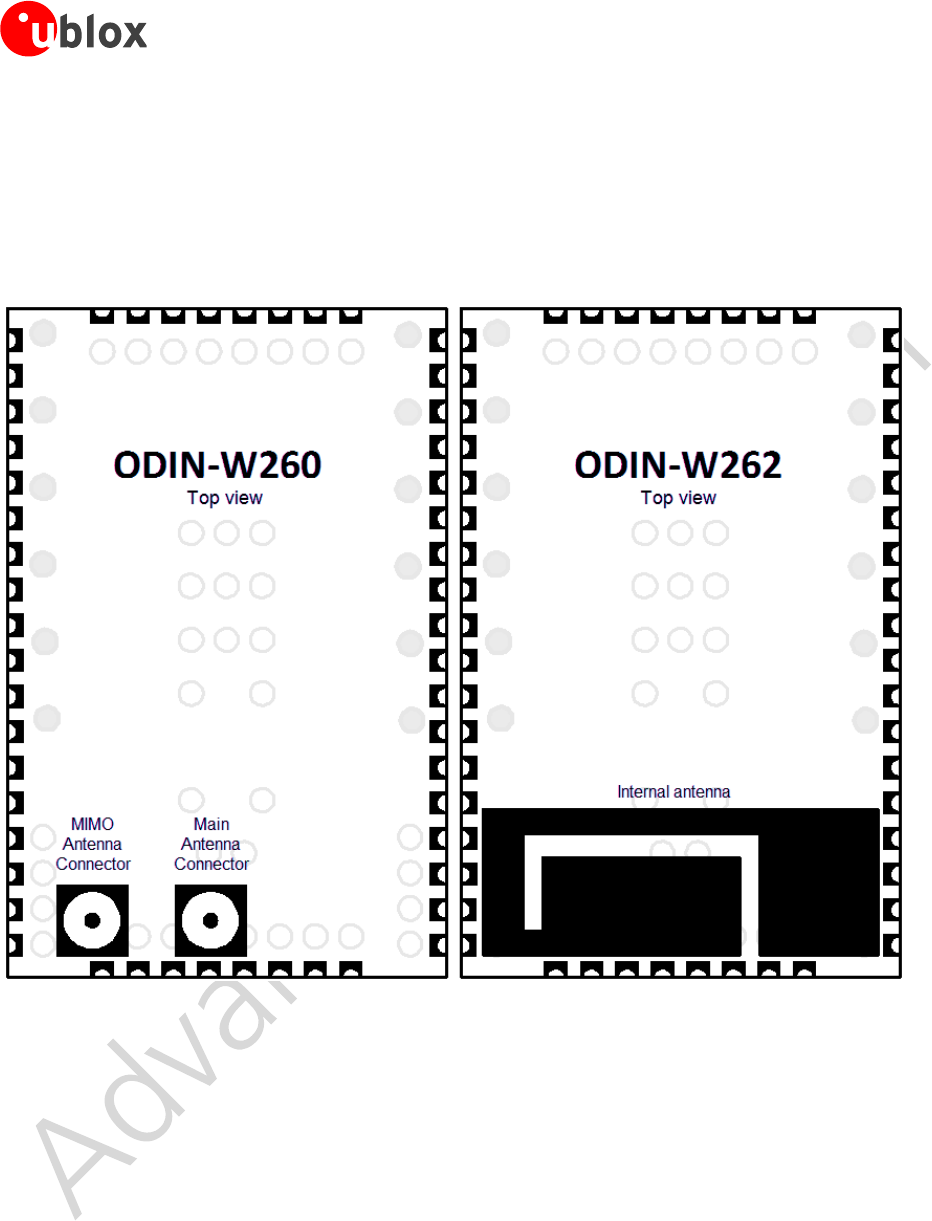
ODIN-W2 series - Data Sheet
UBX-14039949 - R06 Advance Information Interfaces
Page 11 of 44
2.2.1 Antenna connectors and internal antenna
The ODIN-W260 module has two RF antenna U.FL. coaxial connectors with a characteristic impedance of 50Ω.
The main antenna connector supports both Bluetooth and dual-band Wi-Fi. The second (MIMO) antenna
connector adds support for 2x2 MIMO 2.4GHz single band Wi-Fi.
The ODIN-W262 module has an internal dual-band PIFA antenna and supports Bluetooth and dual-band Wi-Fi
(SISO).
Figure 3: ODIN-W260 with connectors for external antennas and the ODIN-W262 with an internal antenna
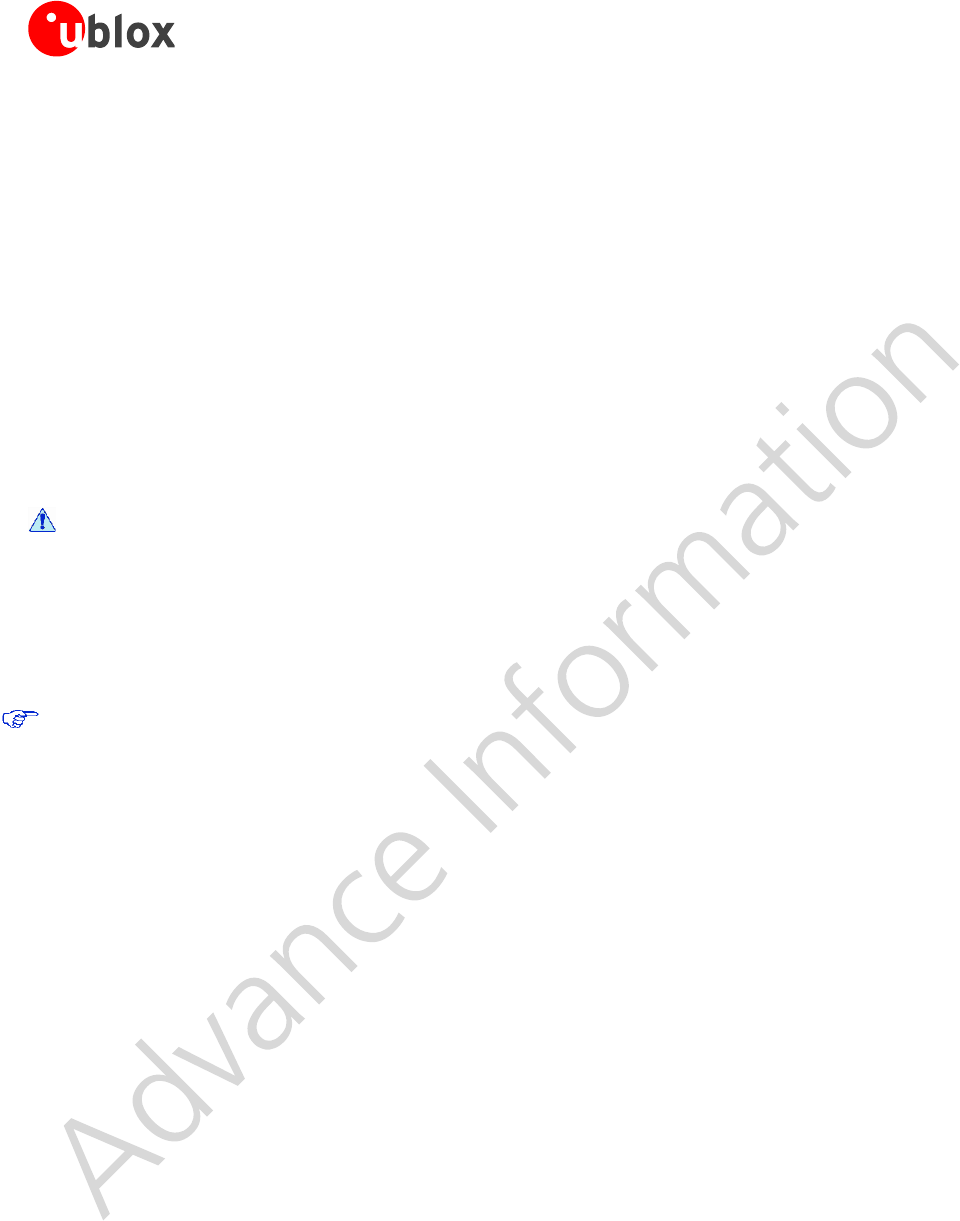
ODIN-W2 series - Data Sheet
UBX-14039949 - R06 Advance Information Interfaces
Page 12 of 44
2.3 Data communication interfaces
The ODIN-W2 series provides several data communication interfaces which are described below.
2.3.1 UART interface
The ODIN-W2 series modules include a 6-wire UART for communication with an application host processor (AT
commands, Data communication and firmware upgrades).
The following UART signals are available:
Data lines (RXD as input, TXD as output)
Hardware flow control lines (CTS as input, RTS as output)
Link status (DTR as output, DSR as input)
It is recommended to use CMOS compatible signal levels. See ODIN-W2 AT Commands Manual [2] and ODIN-
W2 series System Integration Manual [2] for more information about the UART interface.
2.3.2 Ethernet interface
Support for Ethernet interface is planned for version ODIN-W26x-01B-00.
The ODIN-W2 series modules include an integrated Ethernet MAC to communicate with other networked nodes
over a shared medium. It supports 10/100 Mbit/s communication and can operate in both full- and half-duplex
(CSMA/CD).
The Ethernet interface includes:
RMII either for MAC to PHY or Ethernet MAC to MAC communication.
SMI for PHY configuration
The IO voltage of the ODIN-W2 is 1.8 V, which means that the RMII interface operates outside the RMII
specification v1.2. If the RMII is to be connected to a PHY circuit, then that circuit must support 1.8 V
operation. If a direct RMII to RMII connection is used, then a level shifter might be needed depending on
the selected host. The selected hardware setup must be verified on the application board to guarantee
operation.
2.3.2.1 RMII
The RMII use 7 signals in total. The interface requires an external 50 MHz clock source either from a compatible
PHY chip or an external oscillator. The ODIN-W2 module cannot provide this clock signal by itself.
2.3.2.2 SMI (MDC/MDIO management interface)
The two-wire SMI is used to configure the PHY chips. It uses a clock line and a data line to clock data to and
from the PHY chips registers.
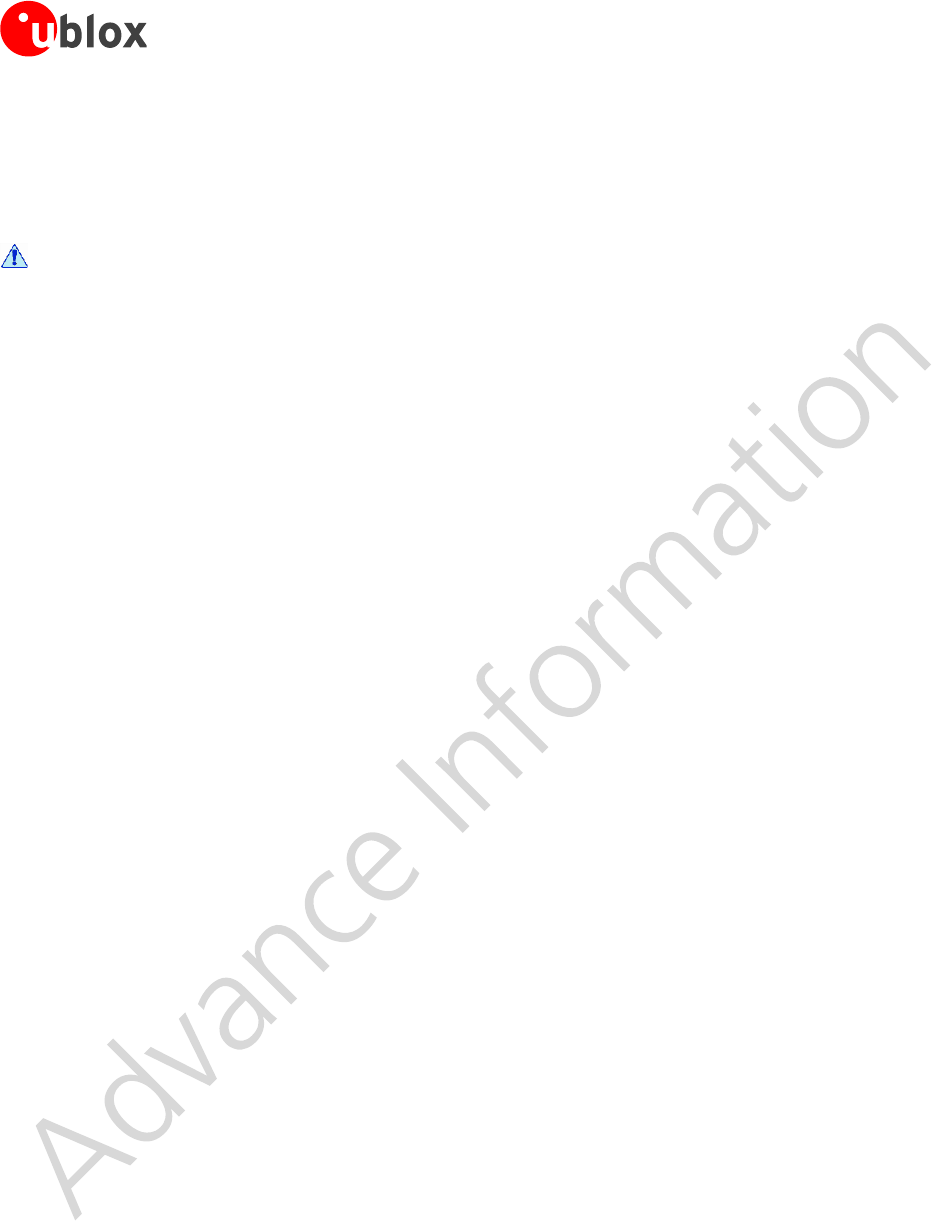
ODIN-W2 series - Data Sheet
UBX-14039949 - R06 Advance Information System functions
Page 13 of 44
3 System functions
3.1 Module power modes
Support for power save mode is available in version ODIN-W26x-01B-00.
The ODIN-W2 series module does not have an internal low power oscillator (LPO) which is required for low
power modes. An external 32.768kHz LPO signal can be supplied externally via the LPO_CLK pin if low power
modes are required.
3.2 Module reset
The ODIN-W2 series modules can be reset (rebooted) in one of the following ways:
Low level on the RESET_N pin, which is normally set high by an internal pull-up. This causes a
“hardware” reset of the module. The RESET_N line should be driven by an open drain, open collector or
contact switch.
Using a reset AT command (see the ODIN-W2 AT Commands Manual [2]). This causes an “software”
reset of the module.
3.3 System IO
The module has the following six different configurable IOs that can be used to indicate different system states
or to be used as inputs, thus setting the module in different states:
SWITCH_0
RED
GREEN/SWITCH_1
BLUE
UART_DTR
UART_DSR
See Pin definition section for more information on the separate IOs. For more information on the use and
configuration of the System IOs, see the ODIN-W2 AT Commands Manual [2].
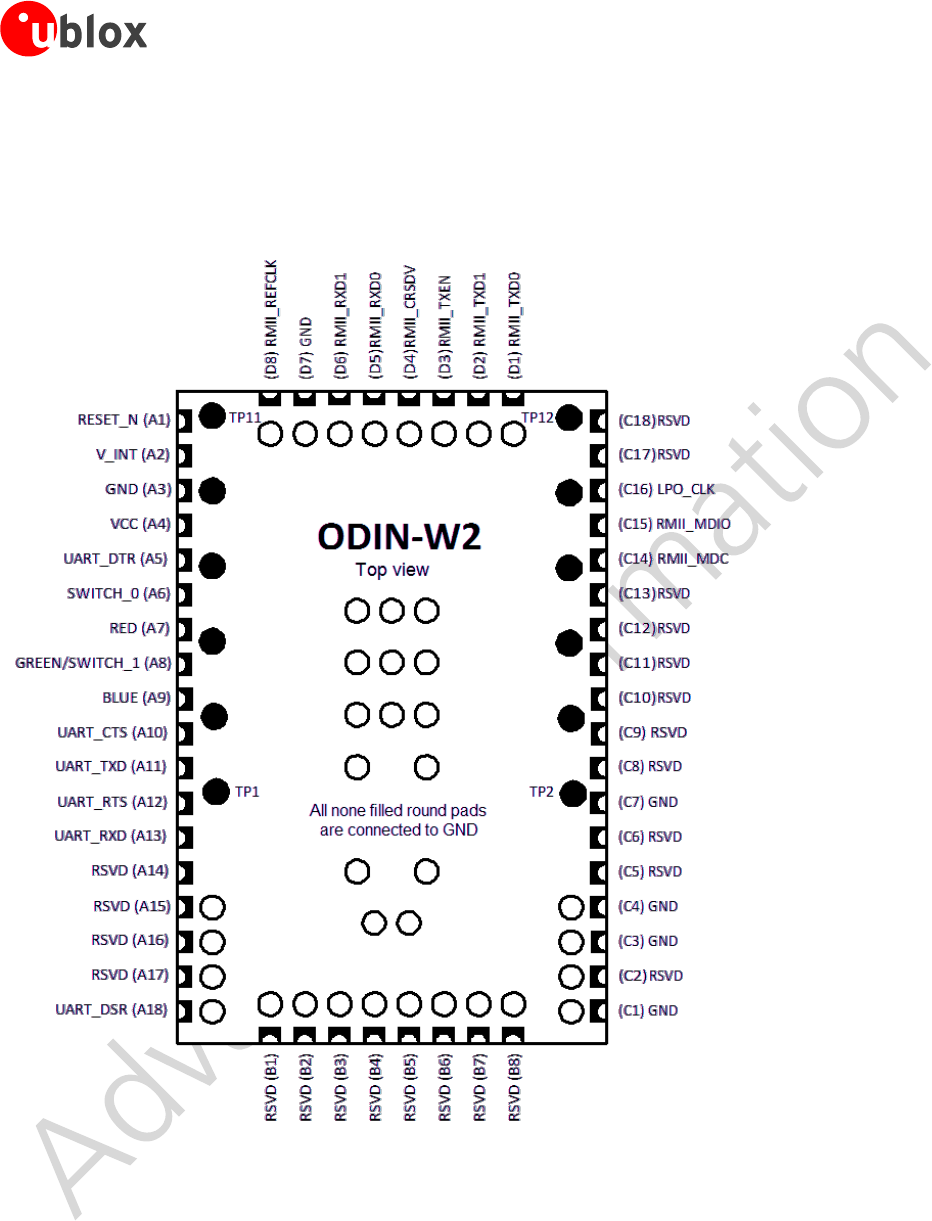
ODIN-W2 series - Data Sheet
UBX-14039949 - R06 Advance Information Pin definition
Page 14 of 44
4 Pin definition
4.1 Pin assignment
Figure 4: ODIN-W2 series pin assignment.
The signals are available on castellation pads on the edge of the PCB. All non-filled round pads are GND pads.
Black circular pads are test and production points that should not be used. RSVD = Reserved, do not connect.

ODIN-W2 series - Data Sheet
UBX-14039949 - R06 Advance Information Pin definition
Page 15 of 44
No
Name
I/O
Description
Remarks
A1
RESET_N
I
External reset input.
Internal active pull-up to V_INT.
A2
V_INT
O
Regulated output of the
internal I/O voltage.
1.8V, maximum output current 100mA. The maximum output
current can be limited by the internal current consumption of
the V_INT rail. See the
Current consumption section for current consumption figures.
A3
GND
N/A
Ground
All GND pads must be connected to ground.
A4
VCC
I
Module power supply.
3.0 - 3.6 V power supply.
A5
UART_DTR
O
UART Data Terminal Ready.
Active low.
Can also be used as a System IO.
See the System IO section for more information.
Also see the ODIN-W2 AT Commands Manual [2] for more
information about the pin functionality.
A6
SWITCH_0
I
Connect on external signal.
Active low.
A secondary function is that the module will restore all factory
settings if both the SWITCH_1 and SWITCH_0 signals are low
during start up.
See the ODIN-W2 AT Commands Manual [2] for more
information about the pin functionality.
A7
RED
O
Logic Red LED Signal.
Active low.
See the System IO section for more information.
Also see the ODIN-W2 AT Commands Manual [2] for more
information about the pin functionality.
A8
GREEN/
SWITCH_1
O/I
This signal is multiplexed:
GREEN: Logic Green LED
Signal.
SWITCH_1: Default Serial
Settings.
Active low.
The GREEN signal is not valid until 500ms after startup. See the
System IO section for more information.
If the level on this pin is pulled-down during start-up the unit
goes back to default serial settings. The SWITCH_1 input is only
active during the first 500ms after startup.
The module will restore all factory settings if both the SWITCH_1
and SWITCH_0 signals are low during start up.
Also see the ODIN-W2 AT Commands Manual [2] for more
information about the pin functionality.
A9
BLUE
O
Logic Blue LED Signal.
Active low.
See the System IO section for more information.
Also see the ODIN-W2 AT Commands Manual [2] for more
information about the pin functionality.
A10
UART_CTS
I
UART Clear To Send,
Hardware flow control.
Active low.
A11
UART_TXD
O
UART Transmit.
A12
UART_RTS
O
UART Request To Send,
Hardware flow control.
Active low.
A13
UART_RXD
I
UART Receive.
A14
RSVD
N/A
Reserved pin.
Leave unconnected.
A15
RSVD
N/A
Reserved pin.
Leave unconnected.
A16
RSVD
N/A
Reserved pin.
Leave unconnected.
A17
RSVD
N/A
Reserved pin.
Leave unconnected.
A18
UART_DSR
I
UART Data Set Ready.
Active low.
Can also be used as a System IO.
See the System IO section for more information.
Also see the ODIN-W2 AT Commands Manual [2] for more
information about the pin functionality.
B1
RSVD
N/A
Reserved pin.
Leave unconnected.
B2
RSVD
N/A
Reserved pin.
Leave unconnected.

ODIN-W2 series - Data Sheet
UBX-14039949 - R06 Advance Information Pin definition
Page 16 of 44
No
Name
I/O
Description
Remarks
B3
RSVD
N/A
Reserved pin.
Leave unconnected.
B4
RSVD
N/A
Reserved pin.
Leave unconnected.
B5
RSVD
N/A
Reserved pin.
Leave unconnected.
B6
RSVD
N/A
Reserved pin.
Leave unconnected.
B7
RSVD
N/A
Reserved pin.
Leave unconnected.
B8
RSVD
N/A
Reserved pin.
Leave unconnected.
C1
GND
N/A
Ground
All GND pads must be connected to ground.
C2
RSVD
N/A
Reserved pin.
Leave unconnected.
C3
GND
N/A
Ground
All GND pads must be connected to ground.
C4
GND
N/A
Ground
All GND pads must be connected to ground.
C5
RSVD
N/A
Reserved pin.
Leave unconnected.
C6
RSVD
N/A
Reserved pin.
Leave unconnected.
C7
GND
N/A
Ground
All GND pads must be connected to ground.
C8
RSVD
N/A
Reserved pin.
Leave unconnected.
C9
RSVD
N/A
Reserved pin.
Leave unconnected.
C10
RSVD
N/A
Reserved pin.
Leave unconnected.
C11
RSVD
N/A
Reserved pin.
Leave unconnected.
C12
RSVD
N/A
Reserved pin.
Leave unconnected.
C13
RSVD
N/A
Reserved pin.
Leave unconnected.
C14
RMII_MDC
O
Management Interface Clock
output
According to RMII specification v1.2 with the exception that
voltage level is 1.8V.
C15
RMII_MDIO
I/O
Management Interface Data
I/O
An external pull-up resistor is required on the bidirectional data
signal.
According to RMII specification v1.2 with the exception that
voltage level is 1.8V.
C16
LPO_CLK
I
Low Power Oscillator clock
input
The module requires an external 32.768 kHz clock for low
power modes.
Leave this pin unconnected if not used as LPO clock input.
C17
RSVD
N/A
Reserved pin.
Leave unconnected.
C18
RSVD
N/A
Reserved pin.
Leave unconnected.
D1
RMII_TXD0
O
Transmit Data output 0
According to RMII specification v1.2 with the exception that
voltage level is 1.8V.
D2
RMII_TXD1
O
Transmit Data output 1
According to RMII specification v1.2 with the exception that
voltage level is 1.8V.
D3
RMII_TXEN
O
Transmit Enable output
Active high.
According to RMII specification v1.2 with the exception that
voltage level is 1.8V.
D4
RMII_CRSDV
I
Carrier Sense/Receive Data
Valid input
Carrier Sense and Receive Data Valid signals are multiplexed
together, multiplexing scheme varies with implementation.
According to RMII specification v1.2 with the exception that
voltage level is 1.8V.
D5
RMII_RXD0
I
Receive Data input 0
According to RMII specification v1.2 with the exception that
voltage level is 1.8V.
D6
RMII_RXD1
I
Receive Data input 1
According to RMII specification v1.2 with the exception that
voltage level is 1.8V.
D7
GND
N/A
Ground
All GND pads must be connected to ground.
D8
RMII_REFCLK
I
Reference Clock input
Continuous 50 MHz reference clock input.
According to RMII specification v1.2 with the exception that
voltage level is 1.8V.
Table 4: ODIN-W2 series pin-out
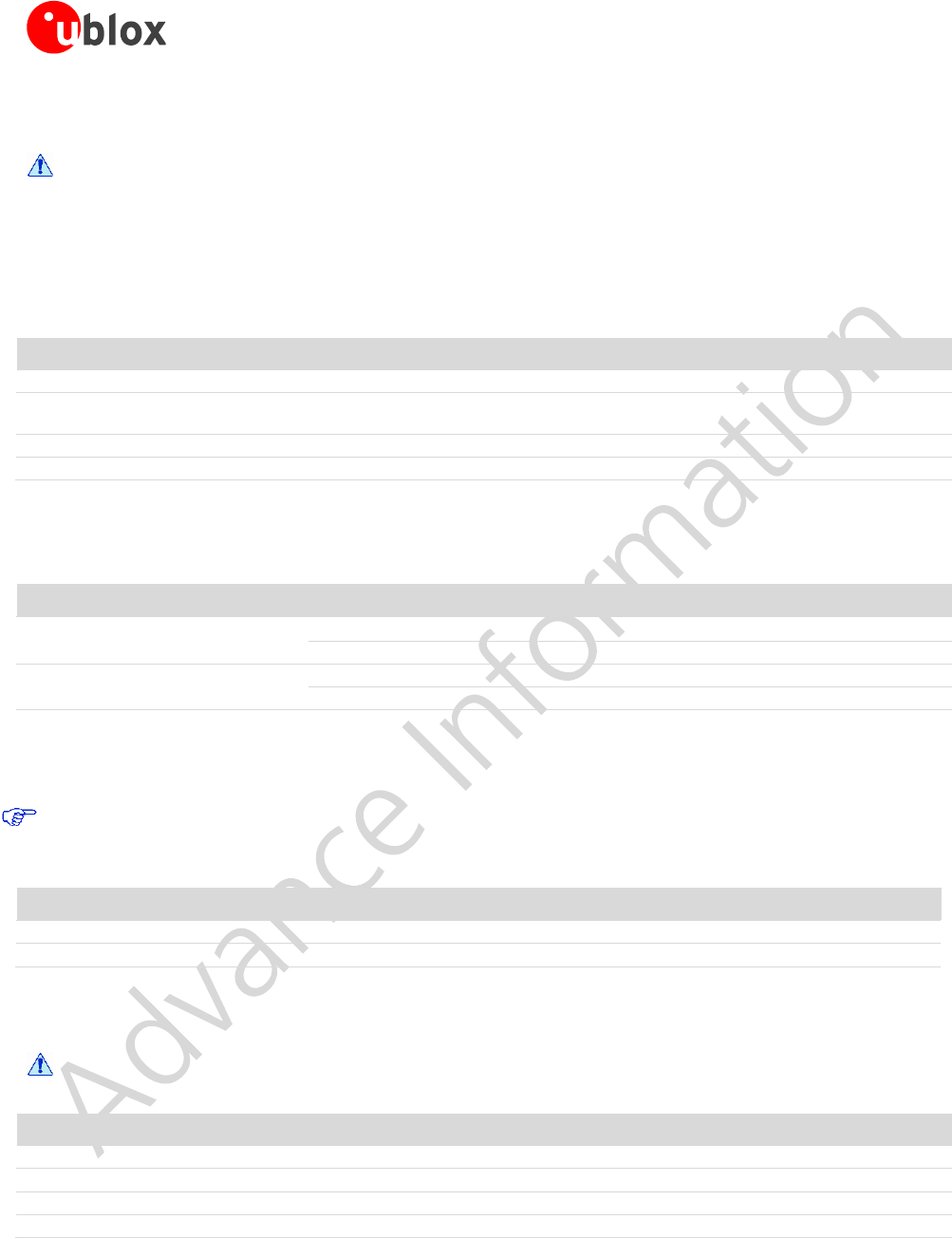
ODIN-W2 series - Data Sheet
UBX-14039949 - R06 Advance Information Electrical specifications
Page 17 of 44
5 Electrical specifications
Stressing the device above one or more of the ratings listed in the Absolute maximum ratings
section may cause permanent damage. These are stress ratings only. Operating the module at
these or at any conditions other than those specified in the Operating conditions section should
be avoided. Exposure to absolute maximum rating conditions for extended periods may affect
device reliability.
5.1 Absolute maximum ratings
Symbol
Description
Condition
Min
Max
Unit
VCC
Module supply voltage
Input DC voltage at VCC pin
-0.3
5.5*
V
GDI
Generic digital interfaces
Input DC voltage at Generic digital
interfaces pins
-0.3
2.2
V
ERS
External reset signal
Input DC voltage at RESET_N pin
-0.3
5.2
V
Tstg
Storage temperature
-40
+85
ºC
* 5.5V up to 10 s cumulative in 7 years, 5V cumulative to 250 s, 4.8 V cumulative to 2.33 years - all includes charging dips and peaks.
Table 5: Absolute maximum ratings
5.1.1 Maximum ESD
Parameter
Max
Unit
Remarks
ESD immunity for antenna connector
shielding
6000
V
Contact Discharge according to IEC 61000-4-2
8000
V
Air Discharge according to IEC 61000-4-2
ESD sensitivity for all pins
1000
V
Human Body Model according to ANSI/ESDA/JEDEC JS-001
250
V
Charged Device Model according to EIA-JEDEC JESD22-C101E
Table 6: Maximum ESD ratings
5.2 Operating conditions
Operating condition ranges define those limits within which the functionality of the device is guaranteed.
5.2.1 Temperature range
Parameter
Min
Max
Unit
Storage temperature
-40
+85
ºC
Operating temperature
-40
+85
ºC
Table 7: Temperature range
5.2.2 Power supply
Read the safety notes in section Guidelines for Efficient and Safe Use before using the modules.
Symbol
Parameter
Min
Typ
Max
Unit
VCC
Supply voltage
3.00
3.30
3.60
V
V_INT
Output voltage
1.76
1.80
1.84
V
IVCC
Supply voltage current drain*
-
-
1.0
A
IV_INT
Output voltage current drain
-
-
100
mA
* See
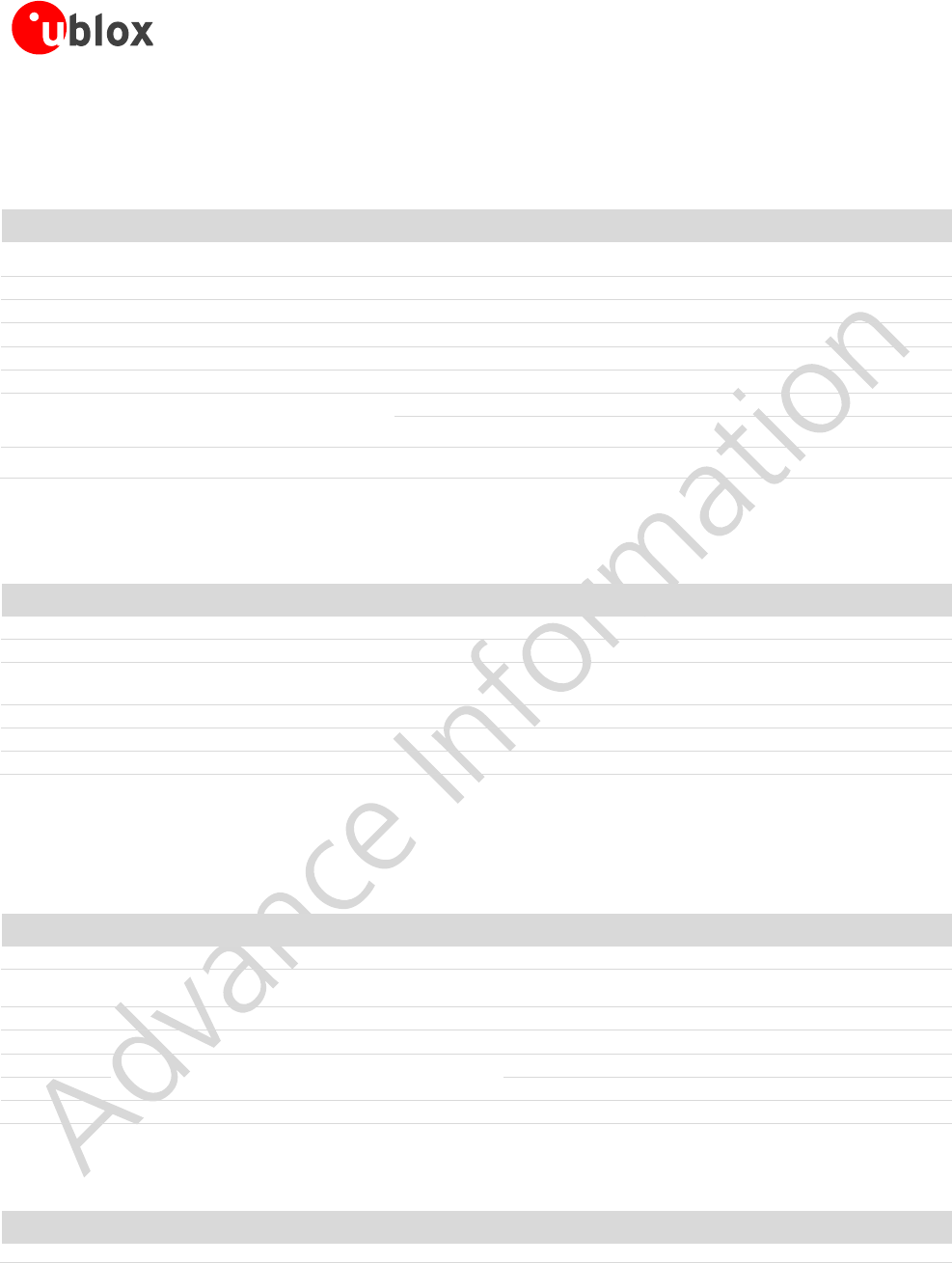
ODIN-W2 series - Data Sheet
UBX-14039949 - R06 Advance Information Electrical specifications
Page 18 of 44
Current consumption section for detailed information.
Table 8: Power supply voltage.
5.2.3 I/O DC characteristics
Symbol
Parameter
Min
Typ
Max
Unit
VIL
LOW level input voltage
0
0.5
V
VIH
HIGH level input voltage
1.31
1.8
2.0
V
VOL
LOW level output voltage
0
0.4
V
VOH
HIGH level output voltage
1.34
1.8
V
IIO
I/O pin sink and source current
4.0*
mA
CIO
I/O pin input capacitance
5
pF
RPU
Internal active pull-up resistance
All IO pins except for UART_RXD
30
40
50
kΩ
UART_RXD
8
11
15
kΩ
RPD
Internal active pull-down resistance
30
40
50
kΩ
* 8.0 mA is possible but the output voltage level is not guaranteed.
Table 9: I/O DC characteristics
5.2.4 Reset characteristics
Symbol
Parameter
Conditions
Min
Typ
Max
Unit
VIL(RESET_N)
RESET_N Input low level voltage
0.5
V
VIH(RESET_N)
RESET_N Input high level voltage
1.3
V
Vhys(RESET_N)
RESET_N Schmitt trigger voltage
hysteresis
200
mV
RPU(RESET_N)
Internal RESET_N pull-up resistance
8
kΩ
CRESET_N
Internal RESET_N capacitance
100
nF
VF(RESET_N)
RESET_N Input filtered pulse
100
ns
Table 10: Reset characteristics
5.2.5 LPO clock
The ODIN-W2 series module does not have an internal low power oscillator (LPO) required for low power modes.
An LPO can be supplied from an external oscillator if low power modes are required.
Symbol
Parameter
Min
Typ
Max
Unit
LPO32.768kHz
Input clock frequency
32.768
kHz
Input slow clock accuracy
(Initial + temp + aging)
±150
ppm
Tr/Tf
Input transition time Tr/Tf -10% to 90%
100
ns
Frequency input duty cycle
20
50
80
%
VIH
Input voltage limits
(Square wave, DC-coupled)
1.31
1.8
V
VIL
0
0.5
V
Input capacitance
10
pF
Table 11: External LPO clock characteristics
5.2.6 Universal asynchronous serial interface (UART)
Symbol
Parameter
Min
Typ
Max
Unit
fbaud
Baud rate
2400
115200
5.25M
bit/s
Table 12: UART characteristics
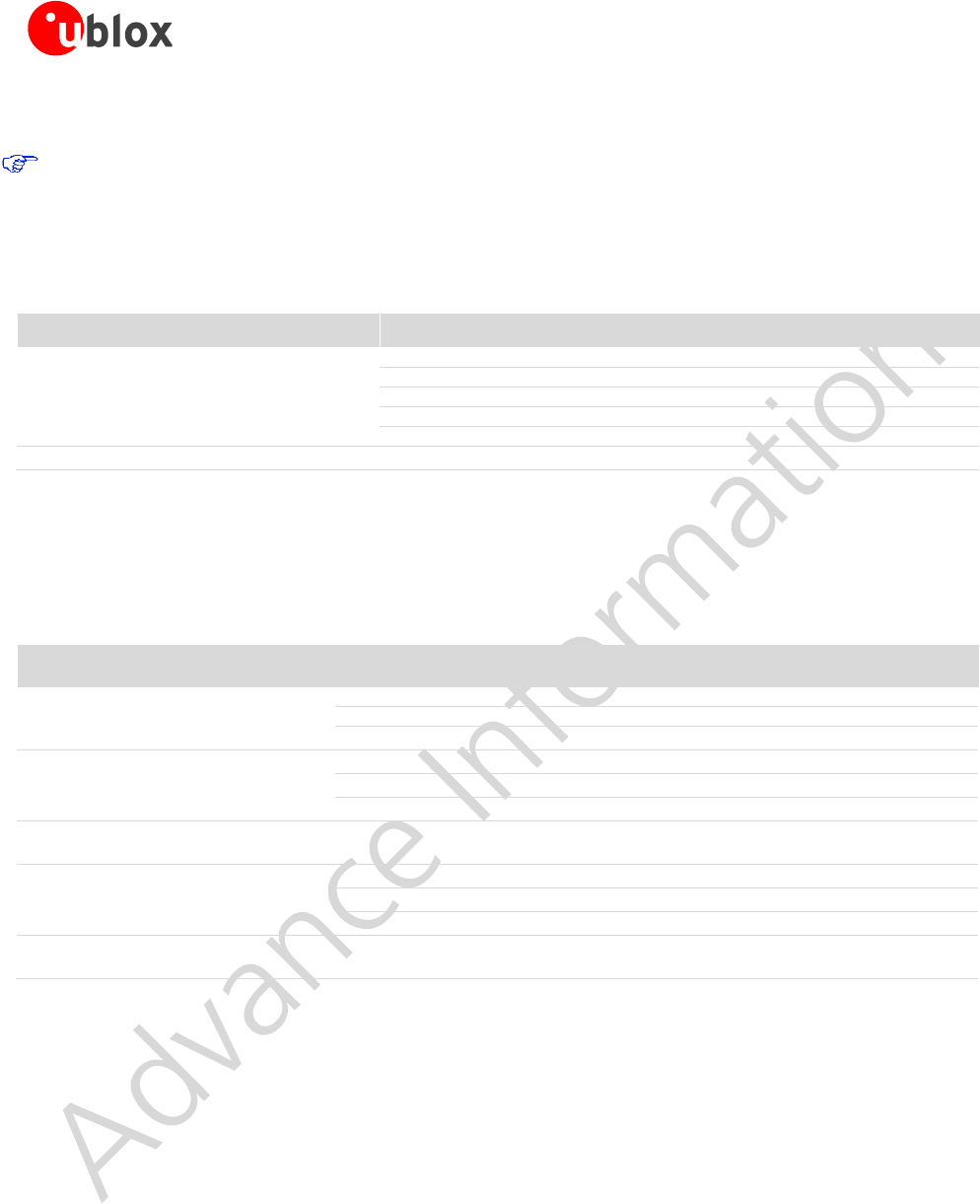
ODIN-W2 series - Data Sheet
UBX-14039949 - R06 Advance Information Electrical specifications
Page 19 of 44
5.3 Current consumption
These measurements were made while running preliminary firmware (see the product version information
on page 2) and are subject to change. No power save functionality is supported yet and especially the idle
current consumption will be significantly reduced in coming firmwares.
5.3.1 General current consumption
VCC = 3.3 V, TA = 25°C unless otherwise specified.
Symbol
Parameter
Conditions
Typ
Peak
Unit
IDD
Supply current
Reset
5.2
6.0
mA
Startup
90
900*
mA
Idle, not connected, default configuration
90
170
mA
Idle, not connected, no running services**
90
120
mA
Stop mode***
TBD
TBD
mA
IDD_MAXIMUM
Absolute maximum current drain
-
1.0
A
* Wi-Fi and Bluetooth calibration during the startup phase causes large short current peaks.
** No server running and Bluetooth Connectable and Discoverable turned off.
*** Feature not supported in the current firmware version. See [1] for more info.
Table 13: General current consumption
5.3.2 Current consumption Wi-Fi 2.4 GHz
VCC = 3.3 V, TA = 25°C unless otherwise specified.
Symbol
Parameter
Conditions
Typ*
Active
Typ**
Peak***
Unit
IDDW24
Supply current not
connected
Scan, 11 channels, 300 ms
93
380
550
mA
Idle, Connected DTIM = 1, Tbeacon = 100 ms
90
350
350
mA
Idle, Connected DTIM = 5****, Tbeacon = 100 ms
TBD
TBD
TBD
mA
IDDW24_TXSISO
Supply current
SISO transmitting
802.11b
170
350
550
mA
802.11g
180
350
550
mA
802.11n****
TBD
TBD
TBD
mA
IDDW24_TXMIMO
Supply current
2x2 MIMO transmitting
802.11n****
TBD
TBD
TBD
mA
IDDW24_RXSISO
Supply current
SISO receiving
802.11b
120
-
550
mA
802.11g
106
-
350
mA
802.11n****
TBD
TBD
TBD
mA
IDDW24_RXMIMO
Supply current
2x2 MIMO receiving
802.11n****
TBD
TBD
TBD
mA
* Average during transmission. UART 3 Mbit/s
** Average value for one transmission period.
*** Measured maximum at maximum output power.
**** Feature not supported in the current firmware version. See [1] for more info.
Table 14: Current consumption for Wi-Fi 2.4 GHz
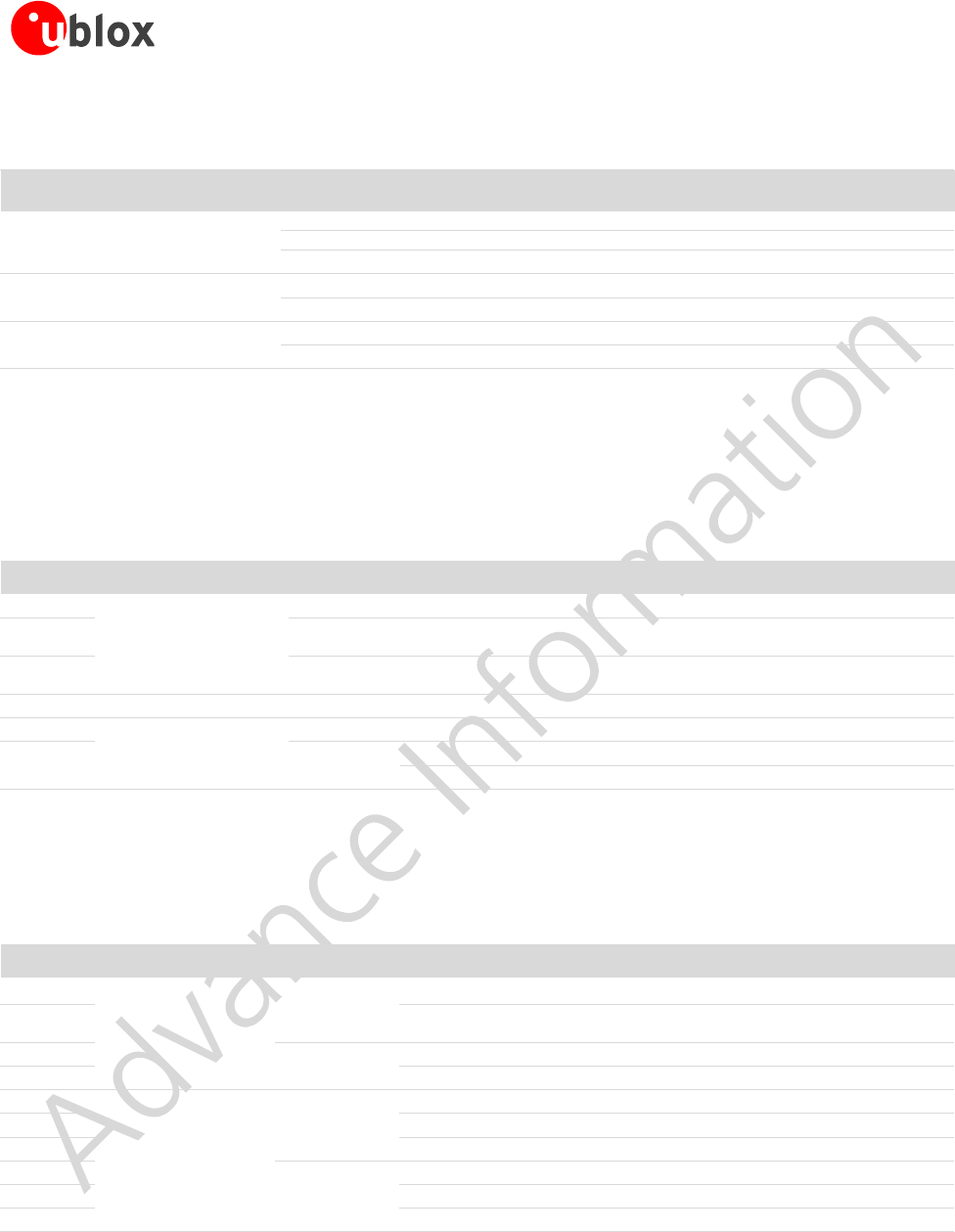
ODIN-W2 series - Data Sheet
UBX-14039949 - R06 Advance Information Electrical specifications
Page 20 of 44
5.3.3 Current consumption Wi-Fi 5 GHz
VCC = 3.3 V, Tamb = 25°C
Symbol
Parameter
Conditions
Typ*
Active
Typ**
Peak***
Unit
IDDW5
Supply current not
connected
Scan, 4 channels, 100 ms
100
400
650
mA
Idle, Connected DTIM = 1, Tbeacon = 100 ms
95
400
650
mA
Idle, Connected DTIM = 5****, Tbeacon = 100 ms
TBD
TBD
TBD
mA
IDDW5_TX
Supply current
SISO transmitting
802.11a
250
400
650
mA
802.11n****
TBD
TBD
TBD
mA
IDDW5_RX
Supply current
SISO receiving
802.11a
102
-
610
mA
802.11n****
TBD
TBD
TBD
mA
* Average during transmission. UART 3 Mbit/s
** Average value for one transmission period.
*** Measured maximum at maximum output power.
**** Feature not supported in the current firmware version. See [1] for more info.
Table 15: Current consumption for Wi-Fi 5 GHz
5.3.4 Current consumption Classic Bluetooth
VCC = 3.3 V, Tamb = 25°C
Symbol
Parameter
Conditions
Typ*
Peak**
Unit
IDDBT_NDNC
Supply current not
connected
Not discoverable, Not connectable
90
100
mA
IDDBT_NDC
Not discoverable, Connectable,
scan interval = TBD, scan window = TBD
90
150
mA
IDDBT_DC
Discoverable, Connectable,
scan interval = TBD, scan window = TBD
90
150
mA
IDDBT_INQ
Supply current inquiry
105
170
mA
IDDBT_IDLE
Supply current connected
Idle
93
170
mA
IDDBT_TX1Mb
Transmitting
115
170
mA
IDDBT_RX1Mb
Receiving
100
150
mA
* Average: The cycle mean value for one transmission period.
** Measured at maximum output power.
Table 16: Current consumption for classic Bluetooth
5.3.5 Current consumption Bluetooth Low Energy (BLE)
VCC = 3.3 V, Tamb = 25°C
Symbol
Parameter
Test conditions
Typ*
Peak**
Unit
IDDBLE_CD_NC
Supply current not
connected
Central device
Idle
91
150
mA
IDDBLE_CD_INQ
Low Energy Inquiry,
Scan interval = TBD, Scan window = TBD
95
170
mA
IDDBLE_PD_NC
Peripheral
device
Idle
90
150
mA
IDDBLE_PD_ADV
Advertising interval = TBD
90
150
mA
IDDBLE_CD_IDLE
Supply current
connected
Central device
Idle
92
150
mA
IDDBLE_CD_TX
Transmitting
95
150
mA
IDDBLE_CD_RX
Receiving
95
150
mA
IDDBLE_PD_IDLE
Peripheral
device
Idle
92
150
mA
IDDBLE_PD_TX
Transmitting
95
150
mA
IDDBLE_PD_RX
Receiving
95
150
mA
* Average: The cycle mean value for one transmission period.
** Measured at maximum output power.
Table 17: Current consumption for Bluetooth Low Energy (BLE)

ODIN-W2 series - Data Sheet
UBX-14039949 - R06 Advance Information Electrical specifications
Page 21 of 44
5.4 RF characteristics
5.4.1 Wi-Fi receiver characteristics 2.4 GHz
VCC = 3.3 V, Tamb = 25 °C
Parameter
Test conditions
Antenna port
Channel /
Freq [MHz]
IEEE
limit
Typ*
Unit
Receive sensitivity
SISO
802.11b, Rate = 1 Mbit/s, PER ≤ 8%
MAIN port
6 / 2437
-76
-94
dBm
802.11b, Rate = 11 Mbit/s, PER ≤ 8%
MAIN port
6 / 2437
-76
-86
dBm
802.11g, Rate = 6 Mbit/s, PER ≤ 10%
MAIN port
6 / 2437
-82
-89
dBm
802.11g, Rate = 54 Mbit/s, PER ≤ 10%
MAIN port
6 / 2437
-65
-72
dBm
802.11n**, Rate = 6.5 Mbit/s (MCS0), PER ≤
10%
MAIN port
6 / 2437
-82
TBD
dBm
802.11n**, Rate = 65 Mbit/s (MCS7), PER ≤
10%
MAIN port
6 / 2437
-64
TBD
dBm
Receive sensitivity
2x2 MIMO
802.11n**, Rate = 13 Mbit/s (MCS8),
PER ≤ 10%
MAIN port (stream 1)
6 / 2437
-64
TBD
dBm
MIMO port (stream 2)
6 / 2437
-64
TBD
dBm
802.11n**, Rate = 130 Mbit/s (MCS15),
PER ≤ 10%
MAIN port (stream 1)
6 / 2437
-64
TBD
dBm
MIMO port (stream 2)
6 / 2437
-64
TBD
dBm
* Measured conducted on ODIN-W260, measurement tolerance ±1.0 dB.
** Feature not supported in the current firmware version. See [1] for more info.
Table 18: Receiver characteristics for 2.4 GHz Wi-Fi
5.4.2 Wi-Fi receiver characteristics 5 GHz
VCC = 3.3 V, Tamb = 25 °C
Parameter
Test conditions
Channel /
Freq [MHz]
IEEE
limit
Typ*
Unit
Receive sensitivity
802.11a, Rate = 6 Mbit/s, PER ≤ 10%
36 / 5180
-82
-85
dBm
100 / 5500
-82
-88
dBm
140 / 5825
-82
-86
dBm
802.11a, Rate = 48 Mbit/s, PER ≤ 10%
36 / 5180
-66
-69
dBm
100 / 5500
-66
-73
dBm
140 / 5825
-66
-71
dBm
802.11n**, Rate = 6.5 Mbit/s (MCS0) , PER ≤ 10%
36 / 5180
-82
TBD
dBm
100 / 5500
-82
TBD
dBm
140 / 5825
-82
TBD
dBm
802.11n**, Rate = 65 Mbit/s (MCS7) , PER ≤ 10%
36 / 5180
-64
TBD
dBm
100 / 5500
-64
TBD
dBm
140 / 5825
-64
TBD
dBm
* Measured conducted on ODIN-W260, measurement tolerance ±1.0 dB.
** Feature not supported in the current firmware version. See [1] for more info.
Table 19: Receiver characteristics for 5 GHz Wi-Fi
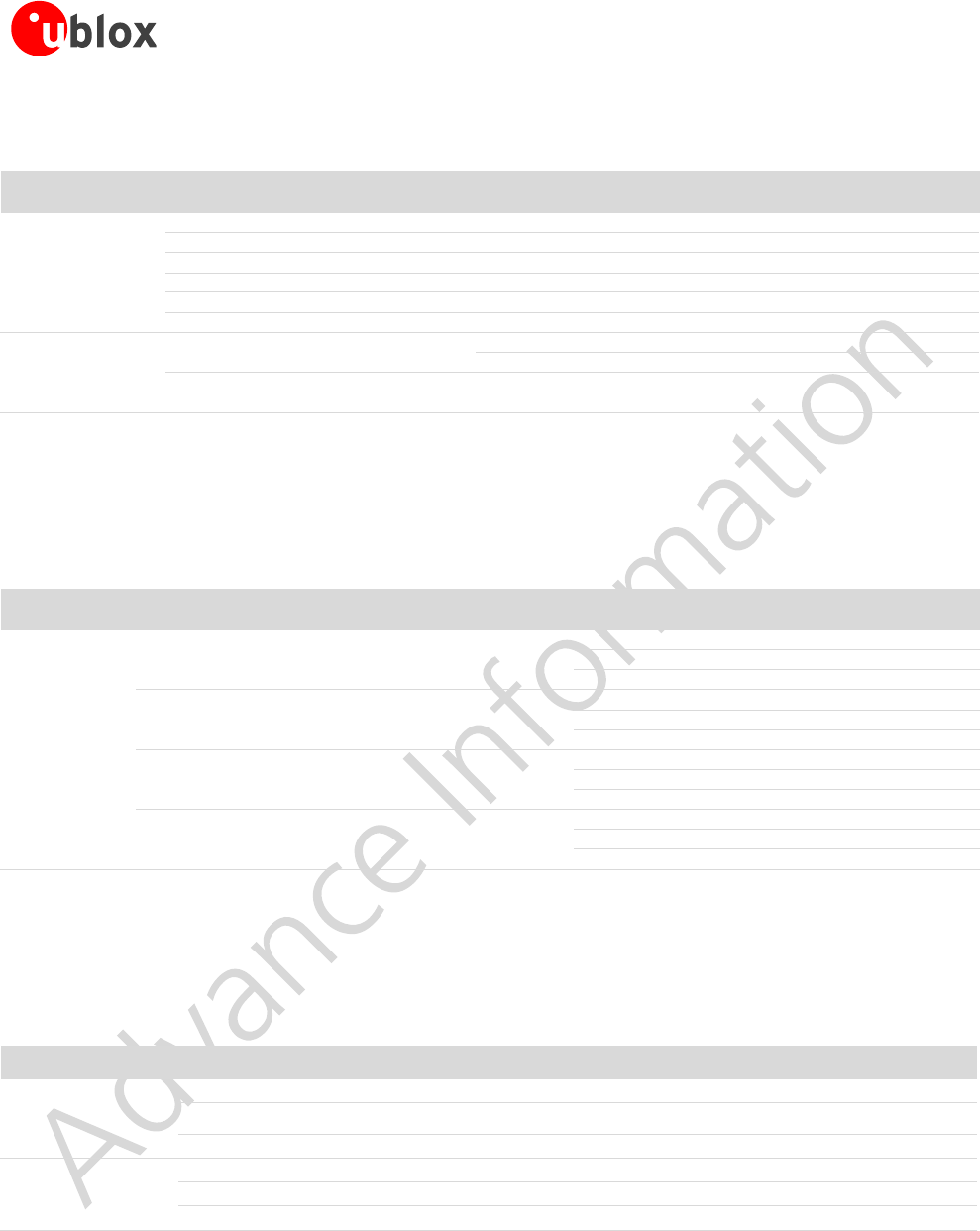
ODIN-W2 series - Data Sheet
UBX-14039949 - R06 Advance Information Electrical specifications
Page 22 of 44
5.4.3 Wi-Fi transmitter characteristics 2.4 GHz
VCC = 3.3 V, Tamb = 25 °C
Parameter
Test conditions
Antenna port
IEEE EVM
limit
EVM*
Typ*
Unit
Transmitting output
power
SISO
802.11b, Rate = 1 Mbit/s
MAIN port
-14
-28
15.2
dBm
802.11b, Rate = 11 Mbit/s
MAIN port
-14
-26
15.6
dBm
802.11g, Rate = 6 Mbit/s
MAIN port
-5
-16
15.2
dBm
802.11g, Rate = 54 Mbit/s
MAIN port
-25
-25
12.3
dBm
802.11n**, Rate = 6.5 Mbit/s (MCS0)
MAIN port
-5
TBD
TBD
dBm
802.11n**, Rate = 65 Mbit/s (MCS7)
MAIN port
-28
TBD
TBD
dBm
Transmitting output
power
2x2 MIMO
802.11n**, Rate = 13 Mbit/s (MCS8)
MAIN port (stream 1)
-5
TBD
TBD
dBm
MIMO port (stream 2)
-5
TBD
TBD
dBm
802.11n**, Rate = 130 Mbit/s (MCS15)
MAIN port (stream 1)
-28
TBD
TBD
dBm
MIMO port (stream 2)
-28
TBD
TBD
dBm
* Measured conducted on ODIN-W260 with max output power, measurement tolerance ±1.0 dB.
Regional power limitation can reduce the max output power (especially on channels close to band edges).
** Feature not supported in the current firmware version. See [1] for more info.
Table 20: Wi-Fi transmitter characteristics 2.4 GHz
5.4.4 Wi-Fi transmitter characteristics 5 GHz
VCC = 3.3 V, Tamb = 25 °C
Parameter
Test conditions
Channel /
Freq [MHz]
IEEE EVM
limit
EVM*
Typ*
Unit
Transmitting
output power
802.11a, Rate = 6 Mbit/s
40 / 5180
-5
-26
14.2
dBm
100 / 5500
-5
-25
14.1
dBm
140 / 5700
-5
-18
15.1
dBm
802.11a, Rate = 54 Mbit/s
40 / 5180
-25
-26
14.2
dBm
100 / 5500
-25
-25
14.1
dBm
140 / 5700
-25
-25
14.7
dBm
802.11n**, Rate = 6.5 Mbit/s (MCS0)
40 / 5180
-5
TBD
TBD
dBm
100 / 5500
-5
TBD
TBD
dBm
140 / 5700
-5
TBD
TBD
dBm
802.11n**, Rate = 65 Mbit/s (MCS7)
40 / 5180
-28
TBD
TBD
dBm
100 / 5500
-28
TBD
TBD
dBm
140 / 5700
-28
TBD
TBD
dBm
* Measured conducted on ODIN-W260 with max output power, measurement tolerance ±1.0 dB.
Regional power limitation can reduce the max output power (especially on channels close to band edges).
** Feature not supported in the current firmware version. See [1] for more info.
Table 21: Wi-Fi transmitter characteristics 5 GHz
5.4.5 Bluetooth classic receiver characteristics
VCC = 3.3 V, Tamb = 25 °C
Parameter
Test conditions
Limit
Typ*
Min*
Unit
Rx sensitivity
BR 1Mbit, GFSK, BER ≤ 0.1%
-70
-89
dBm
EDR 2Mbit, π/4-DQPSK, BER ≤ 0.007%
-70
-90
dBm
EDR 3Mbit, 8DPSK , BER ≤ 0.007%
-70
-83
dBm
Maximum input level
BR 1Mbit, GFSK, BER ≤ 0.1%
-20
-6
dBm
EDR 2Mbit, π/4-DQPSK, BER ≤ 0.1%
-20
-10
dBm
EDR 3Mbit, 8DPSK , BER ≤ 0.1%
-20
-10
dBm
* Measured conducted on ODIN-W260, measurement tolerance ±1.0 dB.
Table 22: Bluetooth classic receiver sensitivity

ODIN-W2 series - Data Sheet
UBX-14039949 - R06 Advance Information Electrical specifications
Page 23 of 44
5.4.6 Bluetooth Low Energy receiver sensitivity
VCC = 3.3 V, Tamb = 25 °C
Parameter
Test conditions
Limit
Typ*
Min*
Unit
Rx sensitivity
PER ≤ 30.8%
-70
-94
dBm
Maximum input level
PER ≤ 30.8%
-10
-6
dBm
* Measured conducted on ODIN-W260, measurement tolerance ±1.0 dB.
Table 23: Bluetooth Low Energy receiver sensitivity
5.4.7 Bluetooth Classic transmitter characteristics
VCC = 3.3 V, Tamb = 25 °C
Parameter
Test conditions
Typ*
Peak*
Unit
Transmitting output
power
BR 1Mbit, GFSK
10.0
11.0
dBm
EDR 2Mbit, π/4-DQPSK
5.0
8.0
dBm
EDR 3Mbit, 8DPSK
5.0
8.0
dBm
* Measured conducted on ODIN-W260, measurement tolerance ±1.0 dB.
Table 24: Bluetooth transmitter output power
5.4.8 Bluetooth Low Energy transmitter characteristics
(VCC = 3.3 V, Tamb = 25 °C
Parameter
Test conditions
Typ*
Peak*
Unit
Transmitting output power
5.0
6.0
dBm
* Measured conducted on ODIN-W260, measurement tolerance ±1.0 dB.
Table 25: Bluetooth Low Energy transmitter characteristics
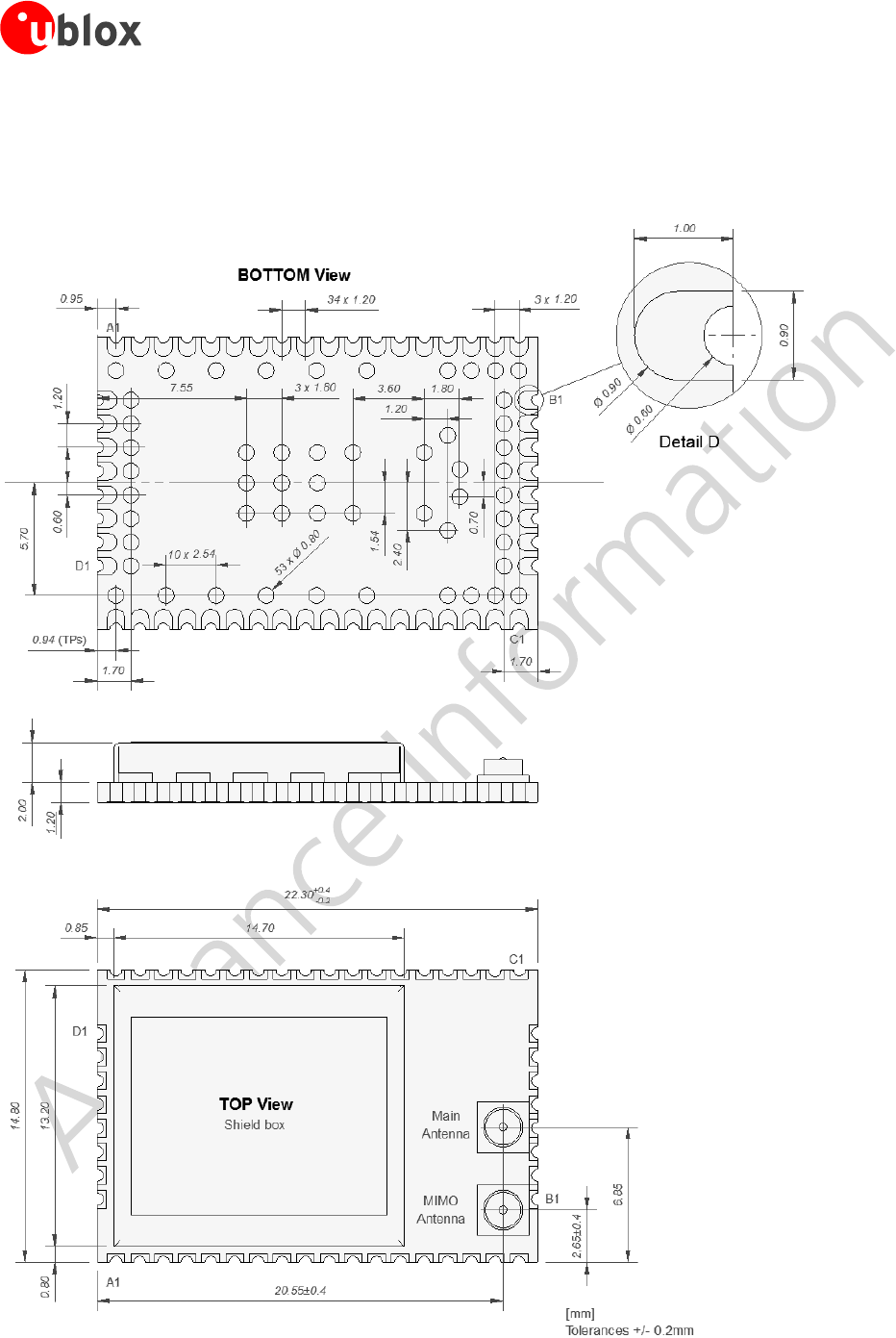
ODIN-W2 series - Data Sheet
UBX-14039949 - R06 Advance Information Mechanical specifications
Page 24 of 44
6 Mechanical specifications
6.1 Dimensions
Figure 5: Physical dimensions of ODIN-W260
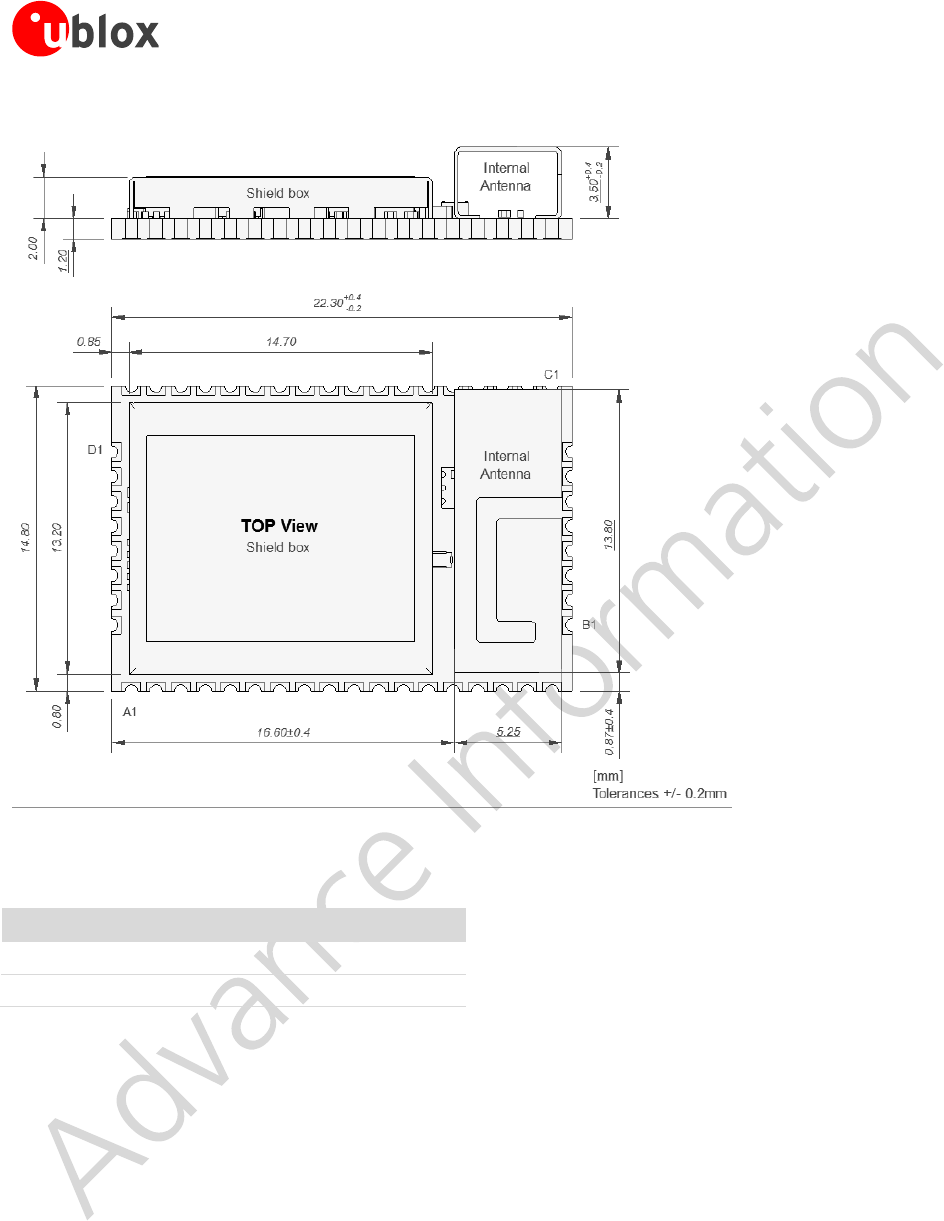
ODIN-W2 series - Data Sheet
UBX-14039949 - R06 Advance Information Mechanical specifications
Page 25 of 44
Figure 6: Physical dimensions of ODIN-W262
6.2 Module weight
Module
Typ
Unit
ODIN-W260
2
g
ODIN-W262
2
g
Table 26: Module weight
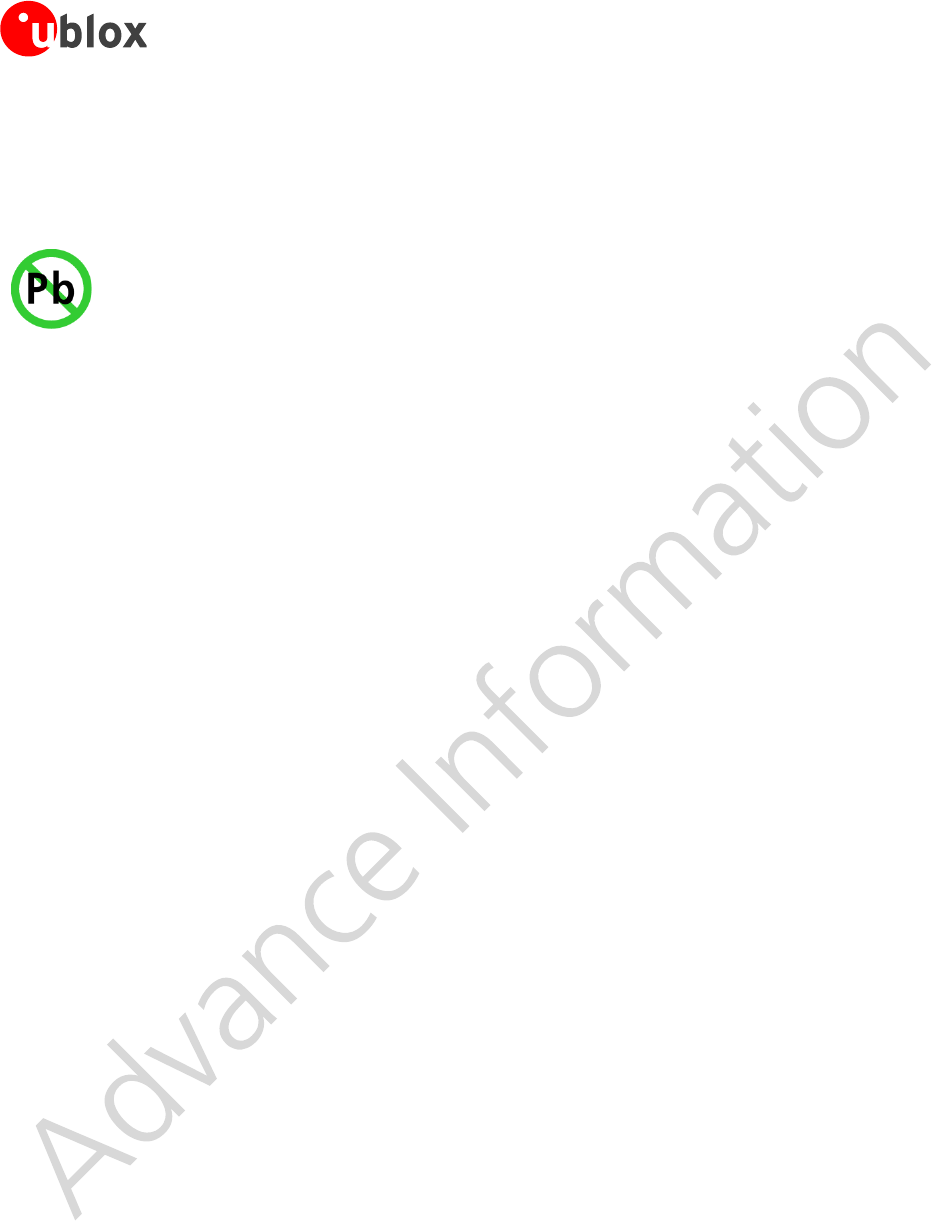
ODIN-W2 series - Data Sheet
UBX-14039949 - R06 Advance Information Qualification and approvals
Page 26 of 44
7 Qualification and approvals
7.1 Compliance with RoHS directive
The ODIN-W2 series modules comply with the "Directive 2011/65/EU of the European
Parliament and the Council on the Restriction of Use of certain Hazardous Substances in
Electrical and Electronic Equipment" (RoHS).
No natural rubbers, hygroscopic materials, or materials containing asbestos are employed.
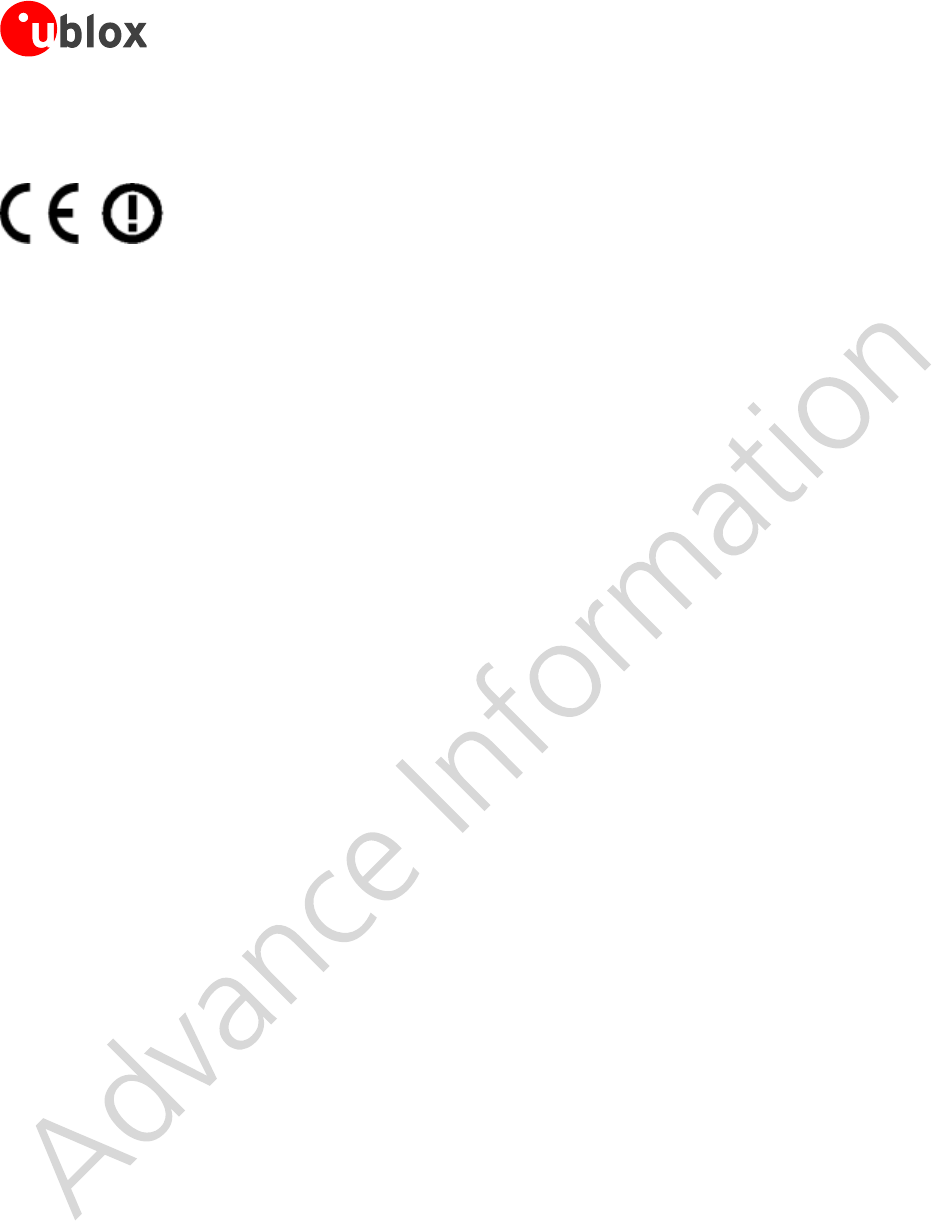
ODIN-W2 series - Data Sheet
UBX-14039949 - R06 Advance Information Qualification and approvals
Page 27 of 44
7.2 Declaration of Conformity
We, u-blox Malmö AB, of
Östra Varvsgatan 4
SE-211 75 Malmö
Sweden
declare under our sole responsibility that our product ODIN-W2 to which this declaration relates, conforms to
the following product specifications:
R&TTE Directive 1999/5/EC
Effective use of frequency spectrum:
EN 300 328 V1.9.1 (2015-02)
EN 301 893 V1.8.1 (2015-03)
EMC:
EN 301 489-1 V1.9.2 (2011-09)
EN 301 489-17 V2.2.1 (2012-09)
EN 61000-6-2 (2005)
Health and safety:
EN 60950-1:2006 + A11:2009 + A1:2010 + A12:2011 + AC:2011 + A2:2013
IEC 60950-1:2005 (2nd Edition) + A1:2009 + A2:2013
EN 62311:2008 (WLAN)
EN 62479:2010 (BT + BLE)
Medical Electrical Equipment
IEC 60601-1-2:2007

ODIN-W2 series - Data Sheet
UBX-14039949 - R06 Advance Information Qualification and approvals
Page 28 of 44
7.3 Safety Compliance
In order to fulfill the safety standard EN 60950-1 the unit must be supplied by a limited power source.
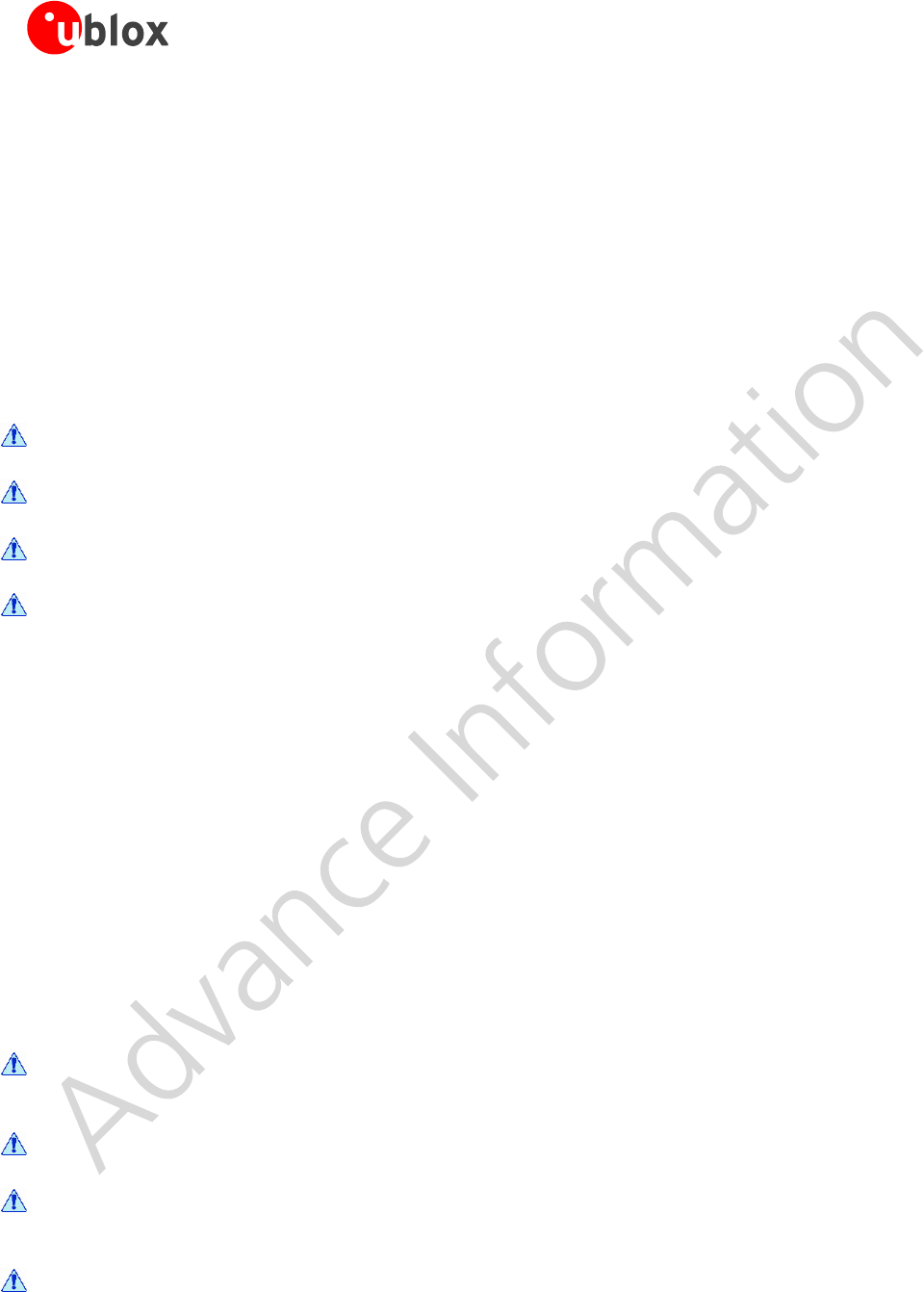
ODIN-W2 series - Data Sheet
UBX-14039949 - R06 Advance Information Qualification and approvals
Page 29 of 44
7.4 FCC and IC Compliance
7.4.1 IC compliance
This device complies with Industry Canada license-exempt RSS standard(s).
Operation is subject to the following two conditions:
1. this device may not cause interference, and
2. this device must accept any interference, including interference that may cause undesired operation of
the device.
Under Industry Canada regulations, this radio transmitter may only operate using an antenna of a type and
maximum (or lesser) gain approved for the transmitter by Industry Canada. To reduce potential radio
interference to other users, the antenna type and its gain should be so chosen that the equivalent isotropically
radiated power (e.i.r.p.) is not more than that necessary for successful communication.
The device for operation in the band 5150-5250 MHz is only for indoor use to reduce the
potential for harmful interference to co-channel mobile satellite systems;
The maximum antenna gain permitted for devices in the bands 5250-5350 MHz and 5470-5725
MHz shall comply with the e.i.r.p. limit; and
the maximum antenna gain permitted for devices in the band 5725-5825 MHz shall comply with
the e.i.r.p. limits specified for point-to-point and non point-to-point operation as appropriate.
Operation in the 5600-5650 MHz band is not allowed in Canada. High-power radars are
allocated as primary users (i.e. priority users) of the bands 5250-5350 MHz and 5650-5850 MHz
and that these radars could cause interference and/or damage to LE-LAN devices.
This equipment complies with IC RSS-102 radiation exposure limits set forth for an uncontrolled environment.
This equipment should be installed and operated with minimum distance 20 cm between the radiator & your
body.
7.4.2 Conformité aux normes d’IC
Cet appareil est conforme à la(aux) norme(s) RSS sans licence d’Industry Canada.
Son utilisation est soumise aux deux conditions suivantes :
1. Cet appareil ne doit pas causer d’interférences et
2. il doit accepter toutes interférences reçues, y compris celles susceptibles d’avoir des effets indésirables
sur son fonctionnement.
Conformément aux réglementations d’Industry Canada, cet émetteur radio ne peut fonctionner qu’à l’aide
d’une antenne dont le type et le gain maximal (ou minimal) ont été approuvés pour cet émetteur par Industry
Canada. Pour réduire le risque d’interférences avec d’autres utilisateurs, il faut choisir le type d’antenne et son
gain de telle sorte que la puissance isotrope rayonnée équivalente (p.i.r.e) ne soit pas supérieure à celle requise
pour obtenir une communication satisfaisante.
Le dispositif de fonctionnement dans la bande 5150-5250 MHz est réservé à une utilisation en
intérieur pour réduire le risqué d'interférences nuisibles à la co-canal systèmes mobiles par
satellite.
Le gain d'antenne maximal autorisé pour les appareils dans les bandes 5250-5350 MHz et 5470-
5725 MHz doit se conformer à la pire limite, et
le gain d'antenne maximal autorisé pour les appareils dans la bande 5725-5825 MHz doivent
être conformes avec le pire limites spécifiées à point-à-ponctuelles et non point-à-point de
fonctionnement selon qu'il convient.
Opération dans la bande 5600-5650 MHz n'est pas autorisée au Canada. Haute puissance radars
sont désignés comme utilisateurs principaux (c.-àutilisateurs prioritaires) des bandes 5250-5350
MHz et 5650-5850 MHz et que ces radars pourraient causer des interférences et / ou des
dommages à dispositifs LAN-EL.
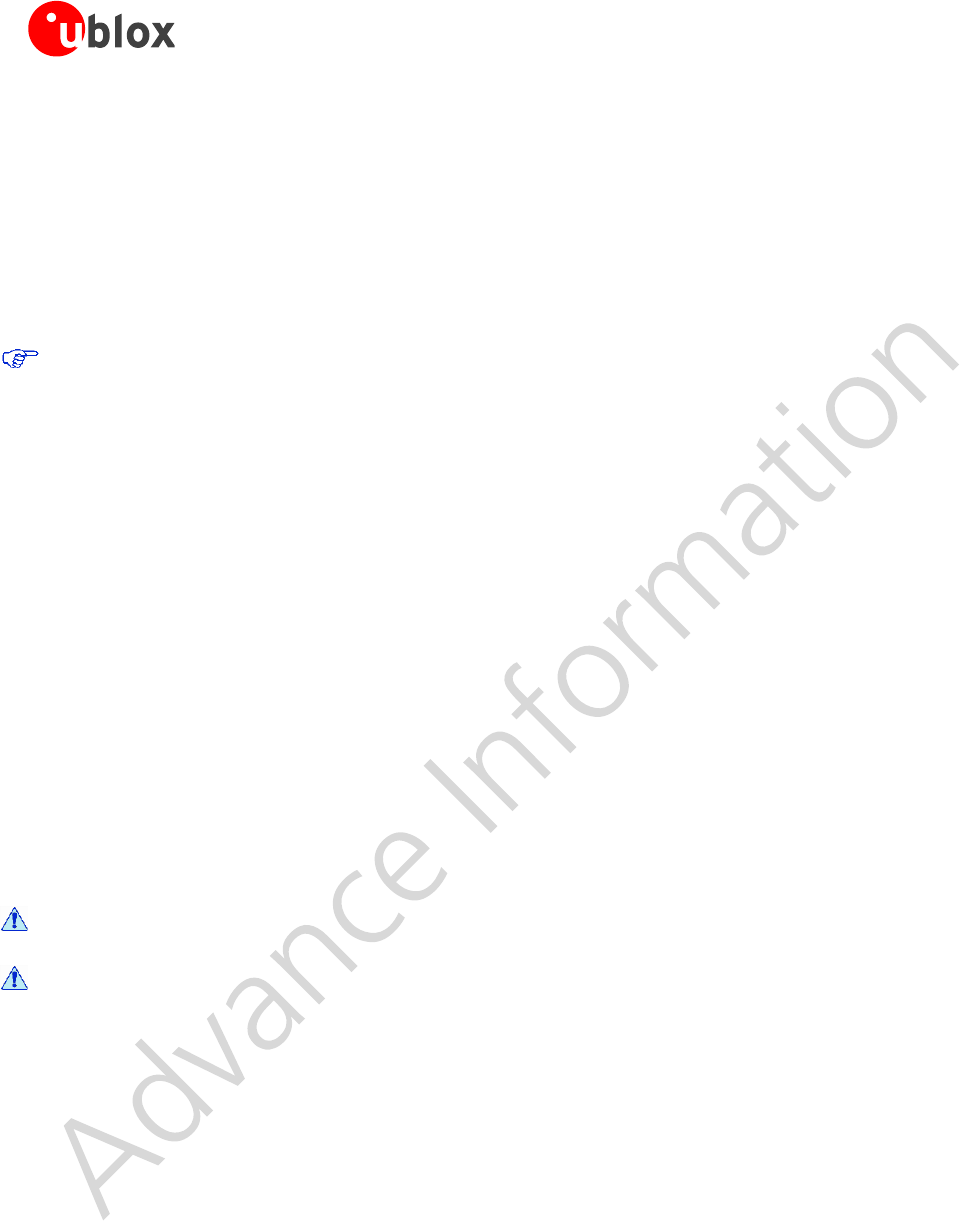
ODIN-W2 series - Data Sheet
UBX-14039949 - R06 Advance Information Qualification and approvals
Page 30 of 44
Cet équipement respecte les limites d’exposition aux rayonnements IC RSS-102 définies pour un environnement
non contrôlé. Il doit être installé et utilisé en maintenant une distance minimum de 20 cm entre le radiateur et
votre corps.
7.4.3 FCC statement
This device complies with Part 15 of the FCC Rules. Operation is subject to the following two conditions:
1. this device may not cause harmful interference, and
2. this device must accept any interference received, including interference that may cause undesired
operation.
This equipment has been tested and found to comply with the limits for a Class B digital device, pursuant
to Part 15 of the FCC Rules. These limits are designed to provide reasonable protection against harmful
interference in a residential installation. This equipment generates, uses and can radiate radio frequency
energy and, if not installed and used in accordance with the instructions, may cause harmful interference
to radio communications. However, there is no guarantee that interference will not occur in a particular
installation. If this equipment does cause harmful interference to radio or television reception, which can
be determined by turning the equipment off and on, the user is encouraged to try to correct the
interference by one or more of the following measures:
Reorient or relocate the receiving antenna.
Increase the separation between the equipment and receiver.
Connect the equipment into an outlet on a circuit different from that to which the receiver is
connected.
Consult the dealer or an experienced radio/TV technician for help.
The ODIN-W2 module is for OEM integrations only. The end-user product will be professionally installed in such
a manner that only the authorized antennas are used.
Any changes or modifications NOT explicitly APPROVED by u-blox could cause the module to cease to comply
with FCC rules part 15, and thus void the user's authority to operate the equipment.
7.4.3.1 Cautions
Any changes or modifications could cause the module to cease to comply with
FCC rules part 15 thus void the user's authority to operate the equipment.
§15.407 statement; in case of absence of information to transmit or operational failure the
module types ODIN-W2 will automatically discontinue transmission.

ODIN-W2 series - Data Sheet
UBX-14039949 - R06 Advance Information Qualification and approvals
Page 31 of 44
7.4.4 Labeling Requirements for End Product
For an end product using the ODIN-W2 modules there must be a label containing, at least, the following
information:
This device contains
FCC ID: PVH0965
IC: 5325A-0965
The label must be affixed on an exterior surface of the end product such that it will be visible upon inspection in
compliance with the modular approval guidelines developed by the FCC.
In accordance with 47 CFR § 15.19 the end product shall bear the following statement in a conspicuous location
on the device:
"This device complies with Part 15 of the FCC Rules.
Operation is subject to the following two conditions;
(1) this device may not cause harmful interference, and
(2) this device must accept any interference received, including interference that may cause undesired
operation."
When the device is so small or for such use that it is not practicable to place the statement above on it, the
information shall be placed in a prominent location in the instruction manual or pamphlet supplied to the user
or, alternatively, shall be placed on the container in which the device is marketed.
In case, where the final product will be installed in locations where the end-user is not able to see the FCC ID
and/or this statement, the FCC ID and the statement shall also be included in the end-product manual.
7.4.4.1 IC requirement
If the end product using the ODIN-W2 module is able to operate in the band 5150-5250 MHz within Canada
(IC) it is only allowed to be used indoor to reduce the potential for harmful interference to co-channel mobile
satellite systems. The label of the end product MUST in this case be marked with the text “For indoor use only”:
This device contains
FCC ID: PVH0965
IC: 5325A-0965
For indoor use only
When the device is so small or for such use that it is not practicable to place the statement above on it, the
information shall be placed in a prominent location in the instruction manual or pamphlet supplied to the user
or, alternatively, shall be placed on the container in which the device is marketed. However, the FCC ID label
including the “For indoor use only” text must be displayed on the device.
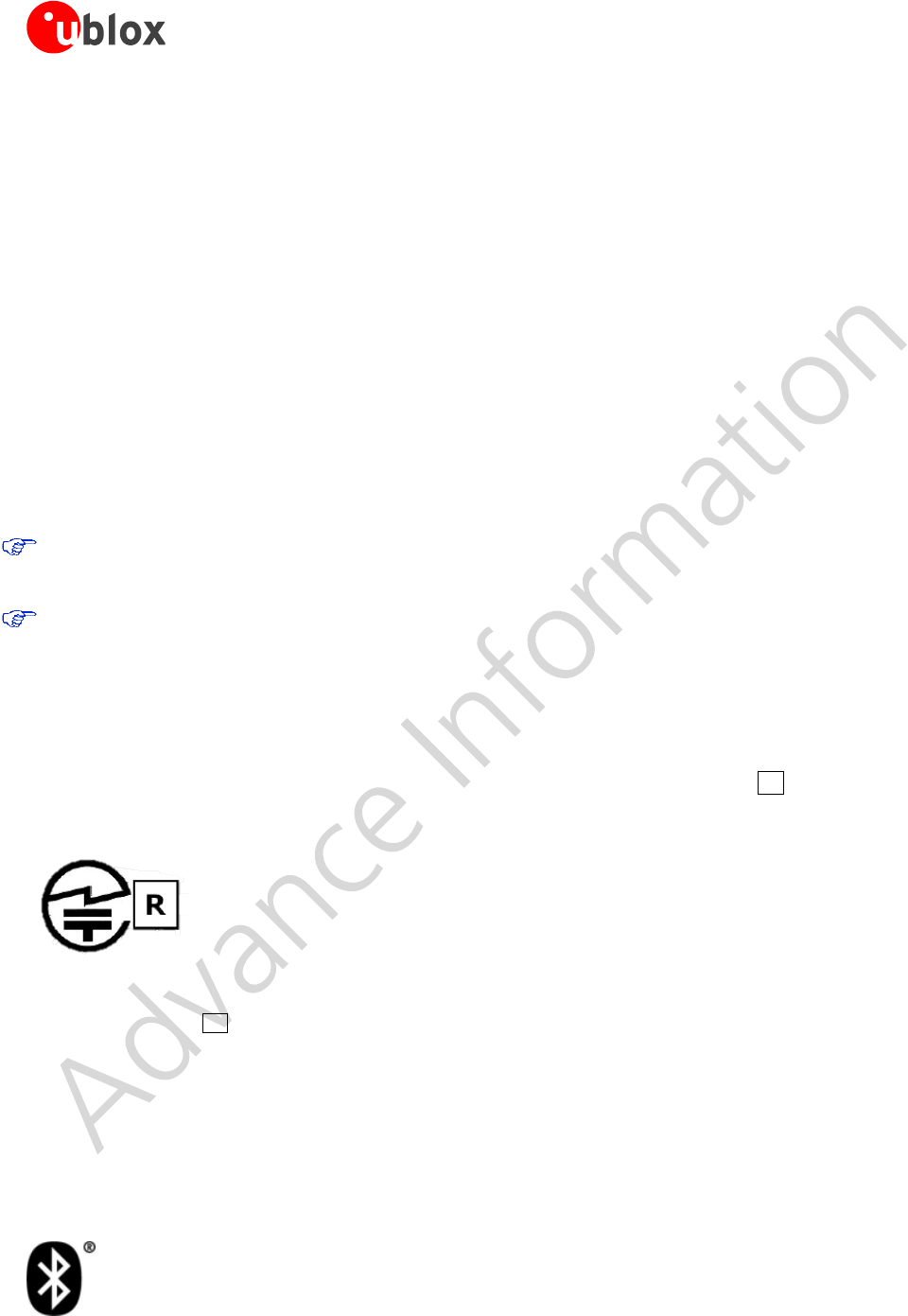
ODIN-W2 series - Data Sheet
UBX-14039949 - R06 Advance Information Qualification and approvals
Page 32 of 44
7.5 Japan Radio Equipment Compliance
The ODIN-W2 module complies with the Japanese Technical Regulation Conformity Certification of Specified
Radio Equipment (ordinance of MPT N°. 37, 1981), Article 2, Paragraph 1:
Item 19 "2.4 GHz band wide band low power data communication system"
Item 19-3 “Low power data communications system in the 5.2/5.3 GHz band”
Item 19-3-2 “Low power data communications system in the 5.6 GHz band”
The ODIN-W2 module is restricted on the Japanese market to be used indoors only if the product is operating in
the 5.2/5.3 GHz band. The information: “Indoor use only” translated into Japanese (この製品は屋内においての
み使用可能です) must be visible:
on the certified end product.
on the product package in which the end product is marketed.
in the users / installation manual of the end product.
The indoor usage information is recommended to be printed close to the Giteki mark but it is also permitted to
place that information on another prominent position.
The ODIN-W2 MIC certification number is 204-510009.
The very small size of the module makes it not reasonable to fit the GITEKI mark and certification number
onto the module label. Instead the Giteki mark and certification number is available in this document, the
ODIN-W2 series System Integration Manual [2] and on the ODIN-W2 package.
When a product integrated with an ODIN-W2 module is placed on the Japanese market, either must:
the ODIN-W2 module be affixed with a label with the Giteki marking below.
In this case is it recommended that the product is marked with “Contains MIC ID: R 204-510009”.
the product be affixed with a label with the Giteki marking below. The marking must be visible for
inspection.
204-510009
この製品は屋内においてのみ使用可能です
Figure 7: Giteki mark, R and the ODIN-W2 MIC certification number. The “Indoor use only” information translated into
Japanese below is mandatory if the product is operating in the 5.2/5.3 GHz band.
The recommended size of the Giteki mark is Ø5.0 mm but the minimum size is Ø3.0 mm.
The end product holder should also include a copy of the Japan Radio Certificate to the end product technical
documentation. See the Contact information in the end of this document for a copy of the Radio Certificate.
7.6 Bluetooth qualification information
The ODIN-W2 series modules have been qualified according to the Bluetooth 4.0 specification.

ODIN-W2 series - Data Sheet
UBX-14039949 - R06 Advance Information Qualification and approvals
Page 33 of 44
For information how to List and Declare your product see the ODIN-W2 series System Integration Manual
[2].
Please note that the ODIN-W2 series module is Bluetooth qualified as
TBD - QD ID TBD. This means that you do not need to do any further qualification.
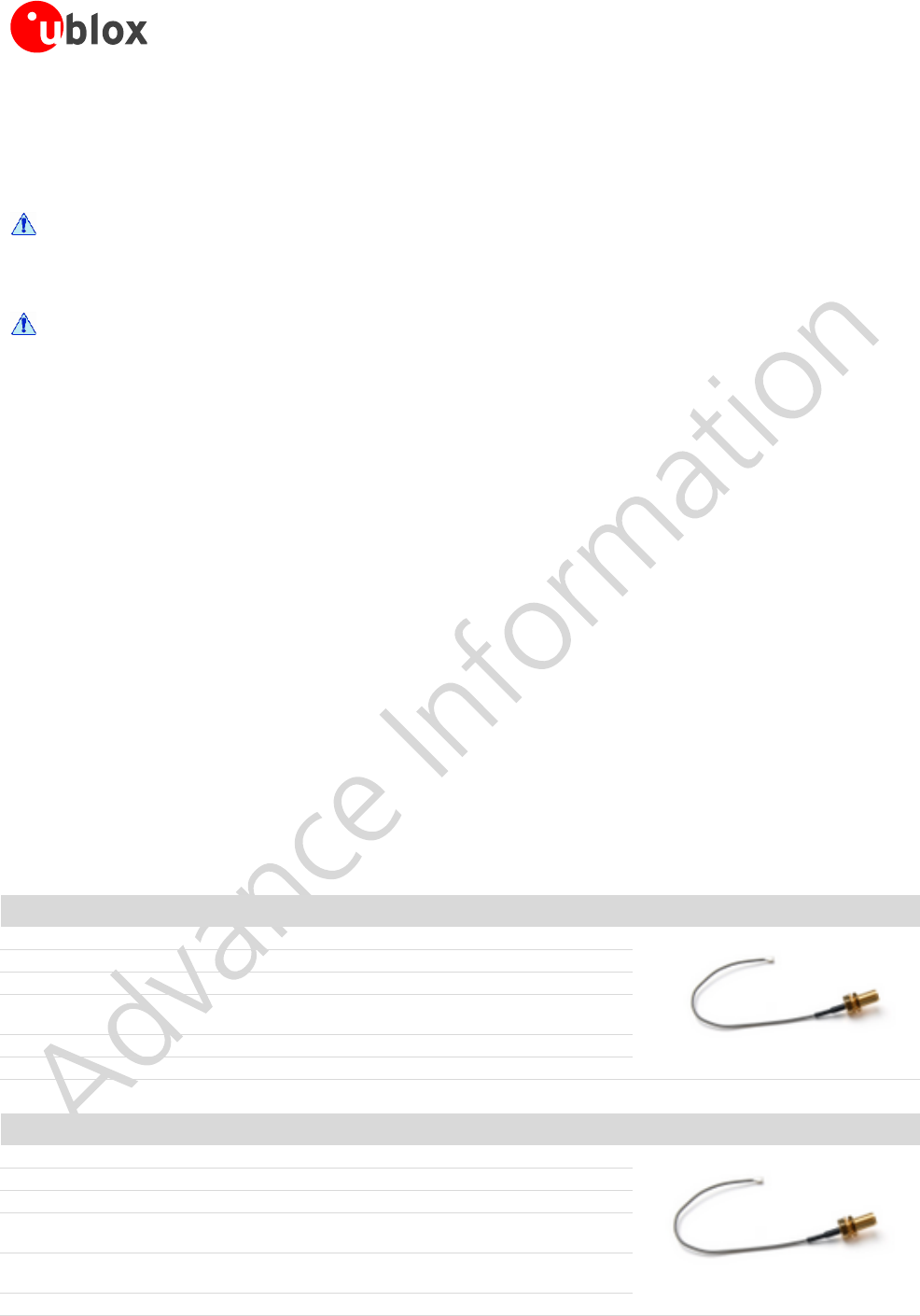
ODIN-W2 series - Data Sheet
UBX-14039949 - R06 Advance Information Antennas
Page 34 of 44
8 Antennas
This chapter gives an overview of the different external antennas that can be fitted to the module.
This radio transmitter IC: 5325A-0965 has been approved by Industry Canada to operate with the
antenna types listed below with the maximum permissible gain and required antenna impedance
for each antenna type indicated. Antenna types not included in this list, having a gain greater
than the maximum gain indicated for that type, are strictly prohibited for use with this device.
Cet émetteur radio IC: 5325A-0965 été approuvé par Industry Canada pour fonctionner avec les
types d’antenne énumérés ci-dessous avec le gain maximum autorisé et l’impédance nécessaire
pour chaque type d’antenne indiqué. Les types d’antenne ne figurant pas dans cette liste et ayant
un gain supérieur au gain maximum indiqué pour ce type-là sont strictement interdits d’utilisation
avec cet appareil.
For each antenna, the "Approvals" field defines in which test reports the antenna is included. Definitions of the
«Approvals» field are:
FCC - The antenna is included in the FCC test reports and thus approved for use in countries that accept
the FCC radio approvals, primarily US.
IC - The antenna is included in the IC (Industrie Canada) test reports and thus approved for use in
countries that accept the IC radio approvals, primarily Canada.
R&TTE - The antenna is included in the R&TTE test reports and thus approved for use in countries that
accept the R&TTE radio approvals, primarily the European countries.
MIC - The antenna is included in the Japanese government affiliated MIC test reports and thus approved
for use in the Japanese market.
In general, antennas with SMD connection, Reverse Polarity SMA connector or U.FL connector are included in
FCC, IC, R&TTE and MIC radio tests. The antennas with SMA connector are included in R&TTE and MIC radio
tests but not in FCC or IC due to FCC/IC regulations.
The external antennas are connected to the board through U.FL connectors. Some of the antennas are
connected directly to the U.FL connector of the board and some are connected using an SMA or reversed
polarity SMA connector through a short U.FL to SMA or reversed polarity SMA adapter cable.
Antenna accessories
Name
U.FL to SMA adapter cable
Connector
U.FL and SMA jack (outer thread and pin receptacle)
Impedance
50 Ω
Minimum cable length
120 mm
Minimum cable loss
0.5 dB, The cable loss must be above the minimum cable loss
to meet the regulatory requirements
Comment
The SMA connector can be mounted in a panel
Approval
R&TTE, MIC
Name
U.FL to Reverse Polarity SMA adapter cable
Connector
U.FL and Reverse Polarity SMA jack (outer thread and pin)
Impedance
50 Ω
Minimum cable length
120 mm
Minimum cable loss
0.5 dB, The cable loss must be above the minimum cable loss
to meet the regulatory requirements
Comment
The Reverse Polarity SMA connector can be mounted in a
panel
Approval
FCC, IC, R&TTE, MIC
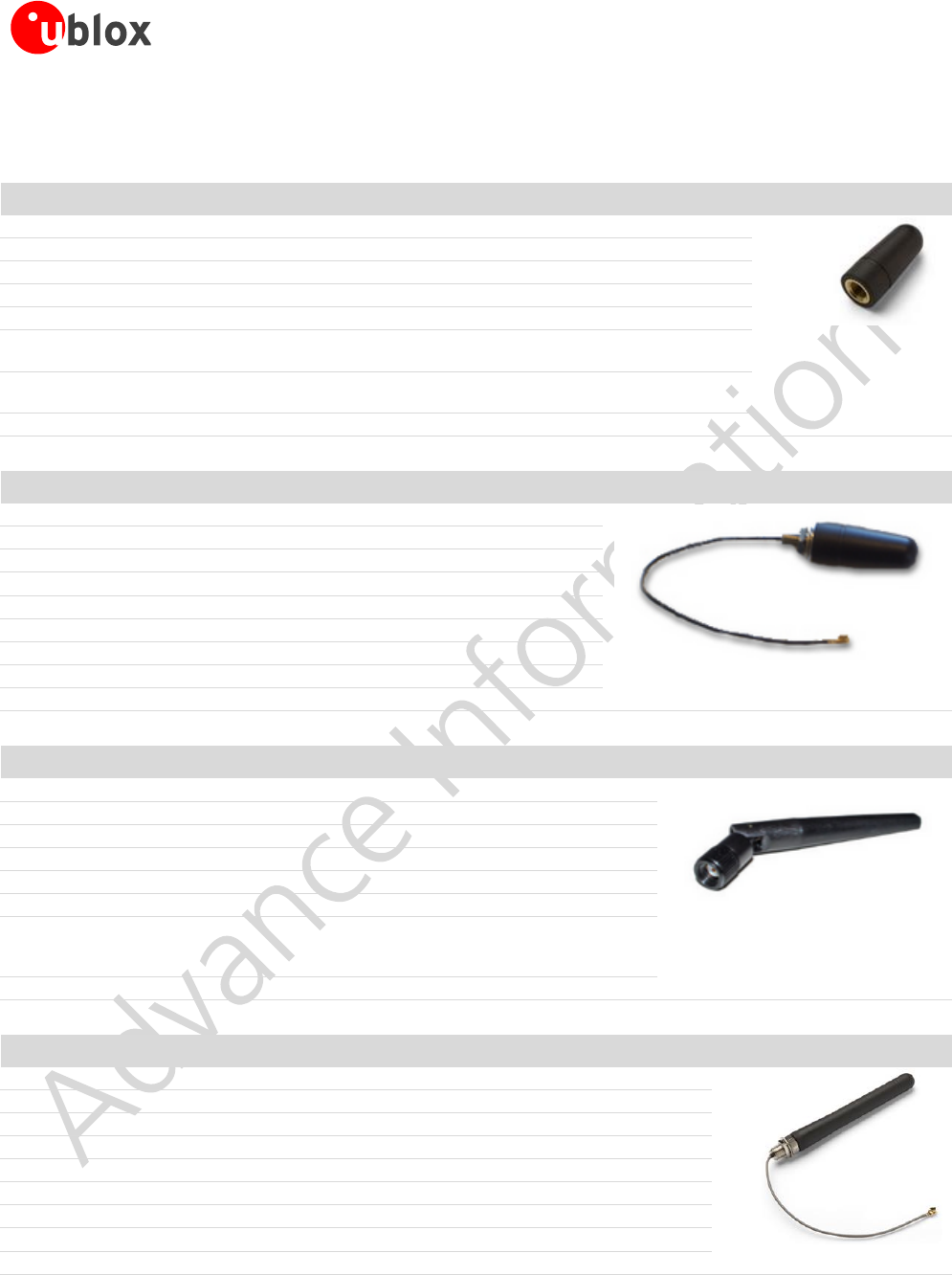
ODIN-W2 series - Data Sheet
UBX-14039949 - R06 Advance Information Antennas
Page 35 of 44
Approved antennas
Single band antennas
Ex-IT 2400 RP-SMA 28-001
Manufacturer
ProAnt
Polarization
Vertical
Gain
+3.0 dBi
Impedance
50 Ω
Size
Ø 12.0 x 28.0 mm
Connector
Reverse Polarity SMA plug (inner thread and pin receptacle). To be mounted on the U.FL to
Reverse Polarity SMA adapter cable.
Comment
An SMA version antenna is also available but not recommended for use (Ex-IT 2400 SMA 28-
001).
Approval
FCC, IC, R&TTE and MIC
Ex-IT 2400 MHF 28
Manufacturer
ProAnt
Polarization
Vertical
Gain
+2.0 dBi
Impedance
50 Ω
Size
Ø 12.0 x 28.0 mm
Cable length
100 mm
Connector
U.FL. connector
Comment
To be mounted on the U.FL connector on the PCB.
Approval
FCC, IC, R&TTE and MIC
Ex-IT 2400 RP-SMA 70-002
Manufacturer
ProAnt
Polarization
Vertical
Gain
+3.0 dBi
Impedance
50 Ω
Size
Ø 10 x 83 mm
Connector
Reverse Polarity SMA plug (inner thread and pin receptacle)
Comment
To be mounted on the U.FL to Reverse Polarity SMA adapter cable (cB-ACC-
38). An SMA version antenna is also available but not recommended for use
(Ex-IT 2400 SMA 70-002).
Approval
FCC, IC, R&TTE and MIC
Ex-IT 2400 MHF 70-001
Manufacturer
ProAnt
Polarization
Vertical
Gain
+3.0 dBi
Impedance
50 Ω
Size
Ø 9.4 x 70.5 mm
Cable length
100 mm
Connector
U.FL. connector
Comment
To be mounted on the U.FL connector on the PCB.
Approval
FCC, IC, R&TTE and MIC
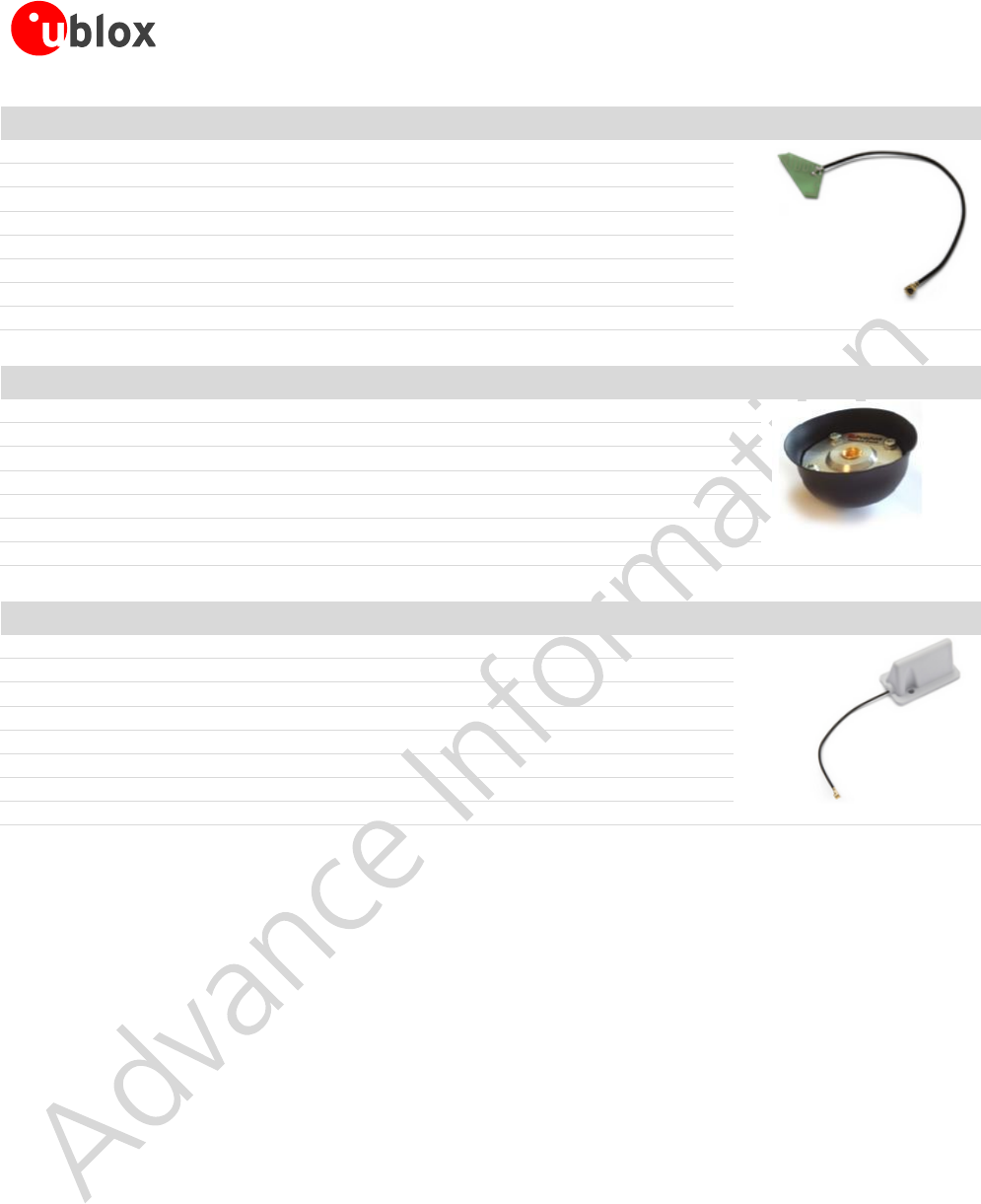
ODIN-W2 series - Data Sheet
UBX-14039949 - R06 Advance Information Antennas
Page 36 of 44
InSide-2400
Manufacturer
ProAnt
Gain
+3.0 dBi
Impedance
50 Ω
Size
27 x 12 mm (triangular)
Cable length
100 mm
Connector
U.FL. connector
Comment
To be mounted on the U.FL connector on the PCB.
Approval
FCC, IC, R&TTE and MIC
FlatWhip-2400
Manufacturer
ProAnt
Gain
+3.0 dBi
Impedance
50 Ω
Size
Ø 50.0 x 30.0 mm
Connector
SMA plug (inner thread and pin)
Comment
To be mounted on the U.FL to SMA adapter cable.
Approval
R&TTE and MIC
Outside-2400
Manufacturer
ProAnt
Gain
+3.0 dBi
Impedance
50 Ω
Size
36.0 x 18.0 x 16.0 mm
Cable length
70 mm
Connector
U.FL. connector
Comment
To be mounted on the U.FL connector on the PCB.
Approval
FCC, IC, R&TTE and MIC
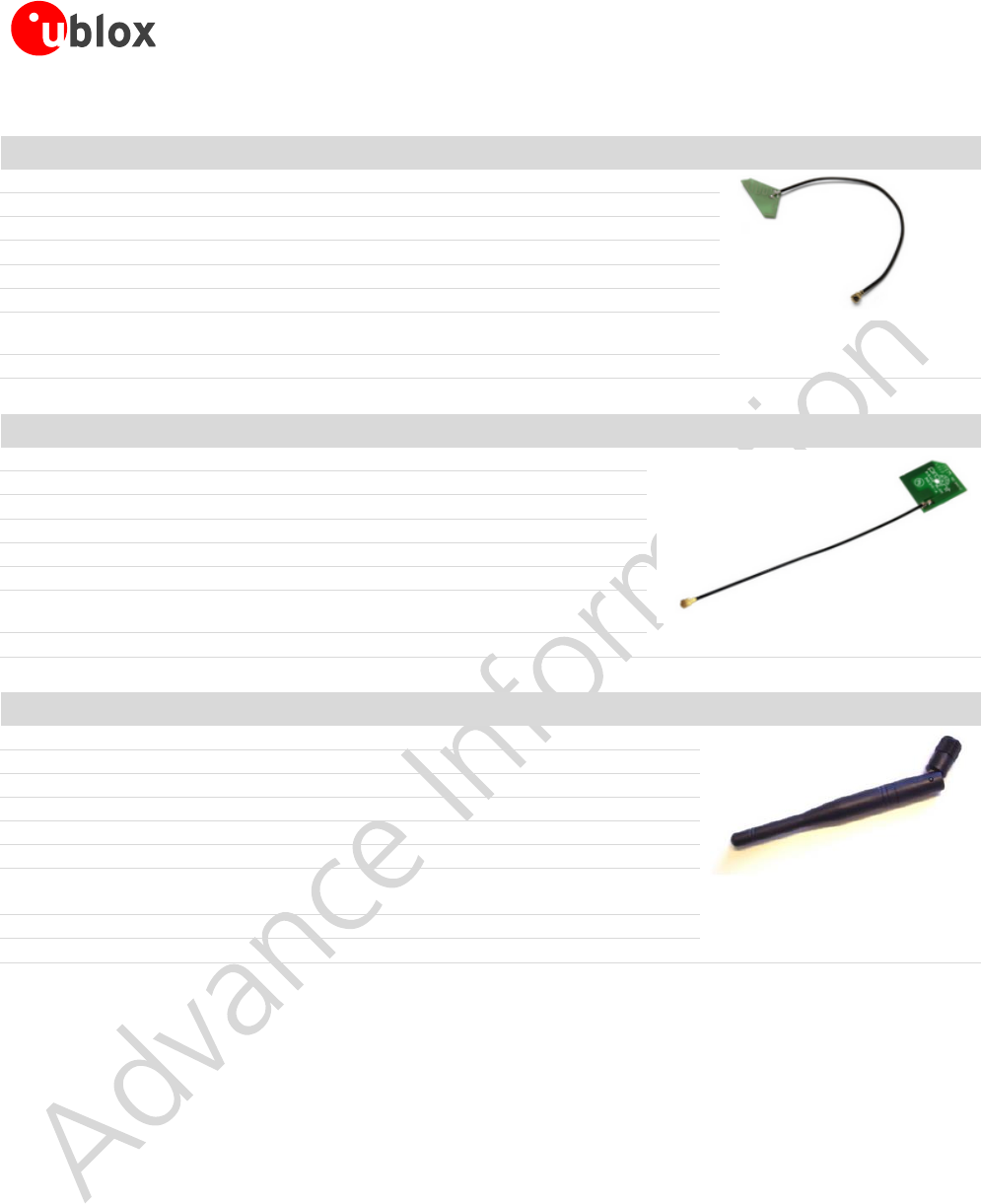
ODIN-W2 series - Data Sheet
UBX-14039949 - R06 Advance Information Antennas
Page 37 of 44
Dual-band antennas
InSide-WLAN
Manufacturer
ProAnt
Gain
+3.0 dBi
Impedance
50 Ω
Size
27 x 12 mm (triangular)
Cable length
100 mm
Connector
U.FL. connector
Comment
Dual-band (2.4 GHz / 5 GHz) antenna to be mounted on the U.FL connector on the
PCB.
Approval
FCC, IC, R&TTE and MIC
InSide WLAN Square 403-100
Manufacturer
ProAnt
Gain
+3.0 dBi
Impedance
50 Ω
Size
24x22x1 mm with mounting hole
Cable length
100 mm
Connector
U.FL. connector
Comment
Dual-band (2.4GHz / 5GHz) antenna to be mounted on the U.FL
connector on the PCB.
Approval
FCC, IC, R&TTE and MIC
Ex-IT WLAN RPSMA / Ex-IT WLAN SMA
Manufacturer
ProAnt
Type
½ wave dipole dual-band antenna
Polarization
Vertical
Gain
+3 dBi
Impedance
50 Ω
Size
107 mm (Straight)
Connector
Reverse Polarity SMA plug (inner thread and pin receptacle)
SMA plug (inner thread and pin)
Comment
To be mounted on the U.FL to SMA or reverse polarity SMA adapter cable.
Approval
FCC, IC, R&TTE and MIC
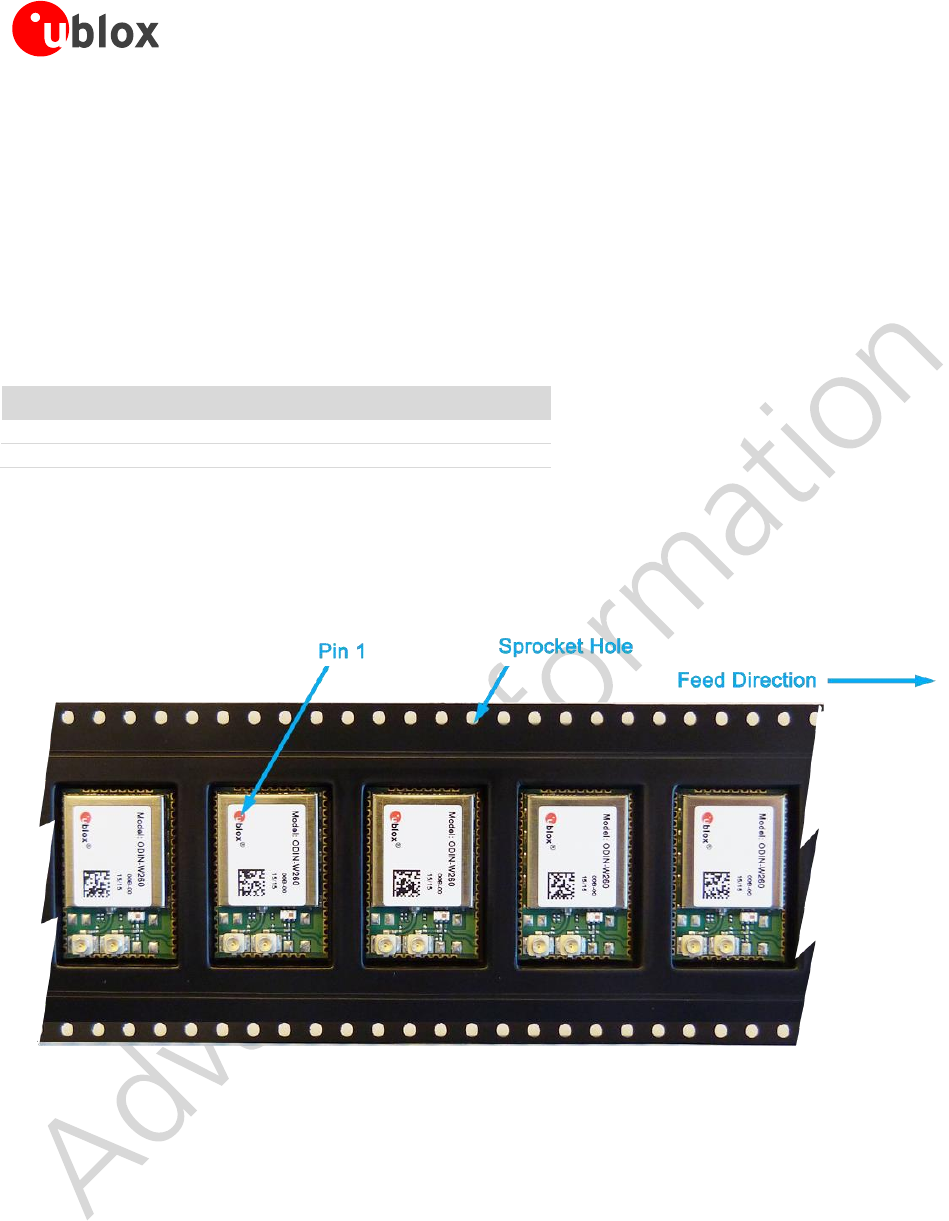
ODIN-W2 series - Data Sheet
UBX-14039949 - R06 Advance Information Product handling and soldering
Page 38 of 44
9 Product handling and soldering
9.1 Packaging
The ODIN-W2 series modules are delivered as hermetically sealed, reeled tapes to enable efficient production,
production lot set-up and tear-down. For more information about packaging, see the u-blox Package
Information Guide [3].
9.1.1 Reels
The ODIN-W2 series modules are delivered on the reel as described in Table 27:
Parameter
Specification
Reel type
B2
Delivery quantity
200
Table 27: Reel information for ODIN-W2 series modules
9.1.2 Tapes
Figure 8 shows the position and the orientation of ODIN-W2 modules as they are delivered on the tape, while
Figure 9 specifies the tape dimensions.
Figure 8: Orientation for ODIN-W2 modules on tape
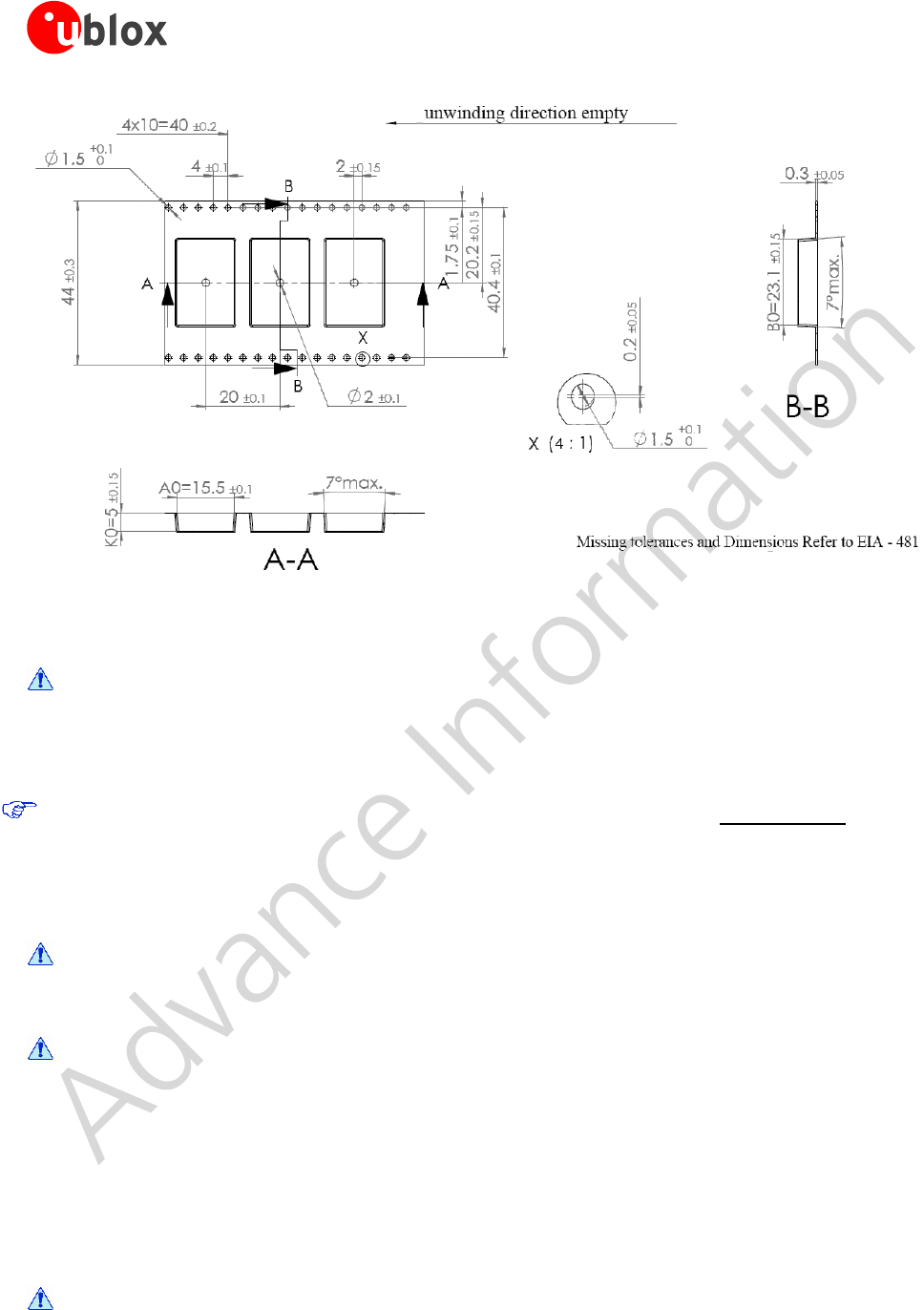
ODIN-W2 series - Data Sheet
UBX-14039949 - R06 Advance Information Product handling and soldering
Page 39 of 44
Figure 9: ODIN-W2 series tape dimensions
9.2 Moisture sensitivity levels
The ODIN-W2 series modules are Moisture Sensitive Devices (MSD) in accordance with the
IPC/JEDEC specification.
The Moisture Sensitivity Level (MSL) relates to the required packaging and handling precautions. The ODIN-W2
series modules are rated at MSL level 4. For more information regarding moisture sensitivity levels, labeling, and
storage, see the u-blox Package Information Guide [3].
For MSL standards, see IPC/JEDEC J-STD-020, which can be downloaded from www.jedec.org.
9.3 Reflow soldering
Reflow profiles are to be selected according to u-blox recommendations (see ODIN-W2 series System Integration
Manual [2]).
Failure to observe these recommendations can result in severe damage to the device.
9.4 ESD precautions
The ODIN-W2 series modules contain highly sensitive electronic circuitry and are Electrostatic
Sensitive Devices (ESD). Handling the ODIN-W2 series modules without proper ESD protection
may destroy or damage them permanently.
The ODIN-W2 series modules are electrostatic sensitive devices (ESD) and require special ESD precautions
typically applied to ESD sensitive components. The Maximum ESD section reports the maximum ESD ratings of
the ODIN-W2 series modules.
Proper ESD handling and packaging procedures must be applied throughout the processing, handling and
operation of any application that incorporates the ODIN-W2 series module. The ESD precautions should be
implemented on the application board where the module is mounted as described in the ODIN-W2 series System
Integration Manual [2].
Failure to observe these recommendations can result in severe damage to the device.
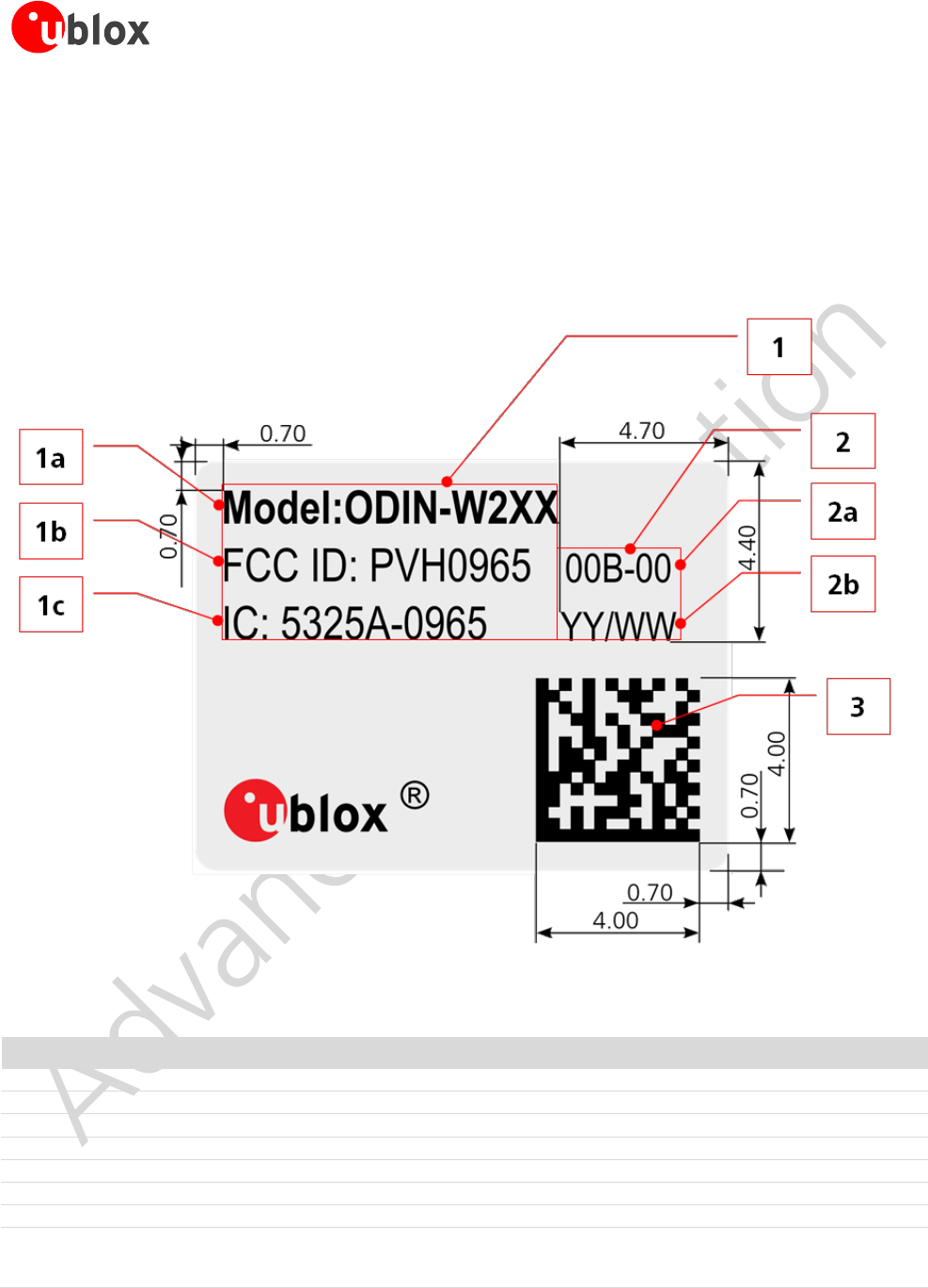
ODIN-W2 series - Data Sheet
UBX-14039949 - R06 Advance Information Labeling and ordering information
Page 40 of 44
10 Labeling and ordering information
10.1 Product labeling
The labels of the ODIN-W2 series modules include important product information as described in this section.
Figure 8 illustrates the label of all the ODIN-W2 series modules, which includes u-blox logo, production lot,
product type number and certification numbers (if applicable).
Figure 10: Location of product type number on the ODIN-W2 series module label
Reference
Description
1
Text box containing Product Name and approval ID:s
1a
Product Name (ID)
1b
FCC ID: (approval in progress)
1c
IC: (approval in progress)
2
Text box containing Product Revision and date of production
2a
Product Revision
2b
Date of unit production encoded YY/WW (year, week)
3
DataMatrix: unit serial number and hardware version:
The 11 first symbols are the unit serial number, 4 last symbols are the hardware and
firmware version encoded HHFF
Table 28: ODIN-W2 series label description

ODIN-W2 series - Data Sheet
UBX-14039949 - R06 Advance Information Labeling and ordering information
Page 41 of 44
10.2 Explanation of codes
Three different product code formats are used. The Product Name is used in documentation such as this data
sheet and identifies all u-blox products, independent of packaging and quality grade. The Ordering Code
includes options and quality, while the Type Number includes the hardware and firmware versions. Table 29
below details these three different formats:
Format
Structure
Product Name
PPPP-TGRV
Ordering Code
PPPP -TGRV-TTQ
Type Number
PPPP -TGRV-TTQ-XX
Table 29: Product code formats
Table 30 explains the parts of the product code.
Code
Meaning
Example
PPPP
Form factor
ODIN
TG
Platform (Technology and Generation)
T – Dominant technology, For example, W: Wi-Fi, B: Bluetooth
G - Generation
W2: Wi-Fi Generation 2
R
Wireless technology; range [0...9]
6: Multi-radio dual-band 2.4+5GHz
V
Variant based on the same platform; range [00…99]
0: default mounting, with connector for external antenna
TT
Major Product Version
00: first revision
Q
Quality grade
A: Automotive
B: Professional
C: Standard
B: professional grade
XX
Minor product version (not relevant for certification)
Default value is 00
Table 30: Part identification code
10.3 Ordering information
Ordering Code
Product
ODIN-W260-00B
Wi-Fi IEEE802.11a/b/g/n (dual-band) 2.4 GHz 2x2 MIMO and Bluetooth dual-mode module with dual U.FL. coaxial
antenna connectors.
ODIN-W262-00B
Wi-Fi IEEE802.11a/b/g/n (dual-band) and Bluetooth dual-mode module with internal dual-band antenna.
Table 31: Product ordering codes

ODIN-W2 series - Data Sheet
UBX-14039949 - R06 Advance Information Appendix
Page 42 of 44
Appendix
A Glossary
Name
Definition
ADC
Analog to Digital Converter
BT
Bluetooth
CAN
Controller Area Network
CTS
Clear To Send
DC
Direct Current
DSR
Data Set Ready
DTR
Data Terminal Ready
EIRP
Equivalent Isotropically Radiated Power
FW
Firmware
GND
Ground
GPIO
General Purpose Input Output
H
High
HW
Hardware
I
Input (means that this is an input port of the module)
IEEE
Institute of Electrical and Electronics Engineers
L
Low
LPO
low Power Oscillator
MIMO
Multi-Input Multi-Output
N/A
Not Applicable
O
Output (means that this is an output port of the module)
PCN / IN
Product Change Notification / Information Note
PD
Pull-Down
PU
Pull-Up
RMII
Reduced Media Independent Interface
RTS
Request To Send
RXD
Receive Data
SMI
Station Management Interface
SPI
Serial Peripheral Interface
TBD
To Be Defined
TXD
Transmit Data
UART
Universal Asynchronous Receiver-Transmitter serial interface
Table 32: Explanation of abbreviations and terms used
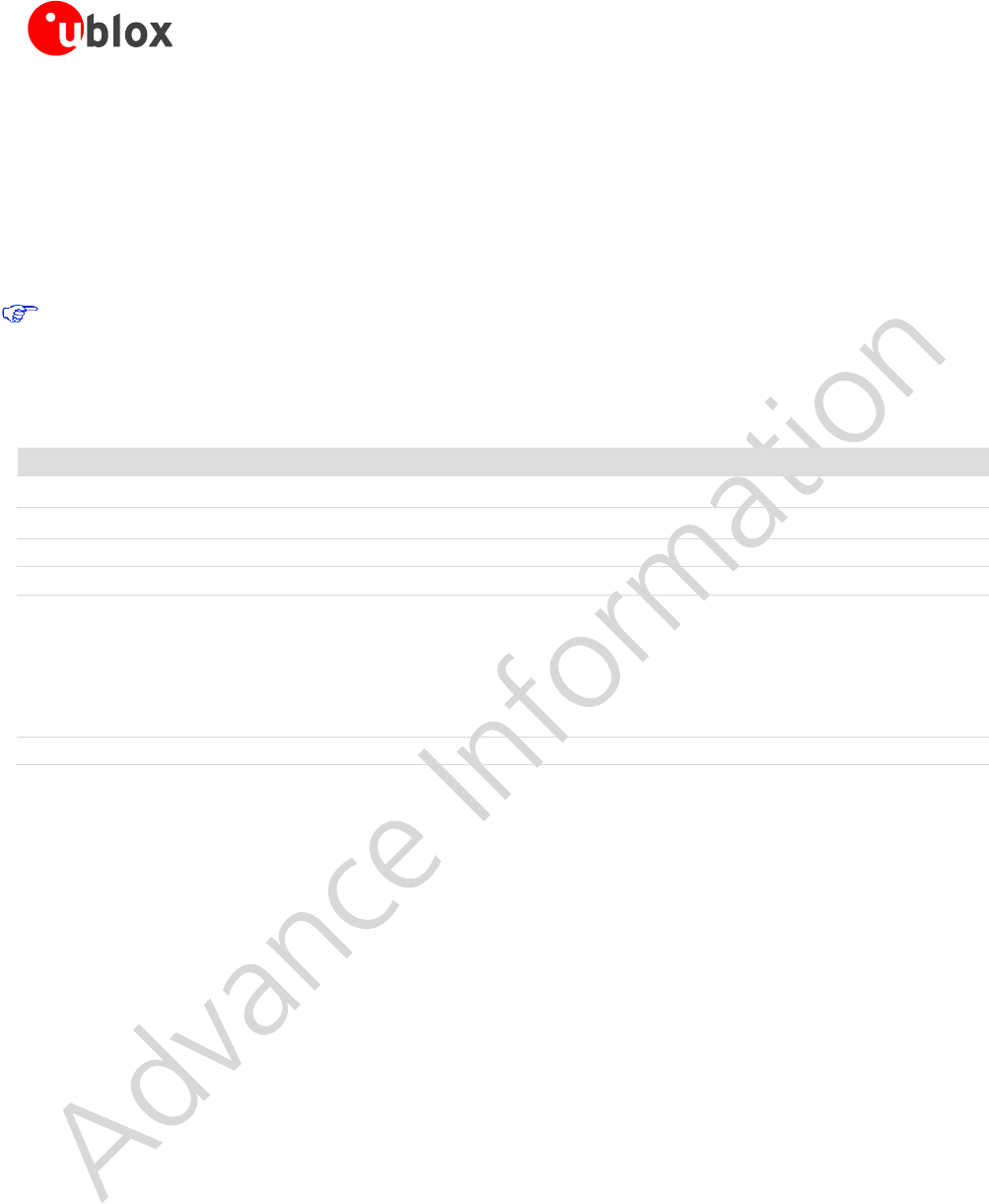
ODIN-W2 series - Data Sheet
UBX-14039949 - R06 Advance Information Related documents
Page 43 of 44
Related documents
[1] ODIN-W2 AT Commands Manual, document number UBX-14044127
[2] ODIN-W2 series System Integration Manual, document number UBX-14040040
[3] u-blox Package Information Guide, document number UBX-14001652
For regular updates to u-blox documentation and to receive product change notifications please register
on our homepage.
Revision history
Revision
Date
Name
Status / Comments
R01
05-Sep-2014
mwej
Initial release
R02
16-Feb-2015
fbro
Minor updates
R03
23-Apr-2015
ajoh
Updated features list, added input from early measurements and label specification
R04
08-July-2015
fbro, kgom
Updated and moved to MS word format
R05
07-Sept-2015
mwej
Major updated with after review:
- Major text updates.
- Some IO voltage levels updated.
- Mechanical outline clarified and some tolerances updated.
- Updated performance measurements with ODIN-W26x SPA FW v0.11.05
- Updated after type approval with approval information.
R06
09-Nov-2015
mwej
Antenna section added and text about indoor restrictions added.

ODIN-W2 series - Data Sheet
UBX-14039949 - R06 Advance Information Contact
Page 44 of 44
Contact
For complete contact information visit us at www.u-blox.com.
u-blox Offices
North, Central and South America
u-blox America, Inc.
Phone: +1 703 483 3180
E-mail: info_us@u-blox.com
Regional Office West Coast:
Phone: +1 408 573 3640
E-mail: info_us@u-blox.com
Technical Support:
Phone: +1 703 483 3185
E-mail: support_us@u-blox.com
Headquarters
Europe, Middle East, Africa
u-blox AG
Phone: +41 44 722 74 44
E-mail: info@u-blox.com
Support: support @u-blox.com
Asia, Australia, Pacific
u-blox Singapore Pte. Ltd.
Phone: +65 6734 3811
E-mail: info_ap@u-blox.com
Support: support_ap@u-blox.com
Regional Office Australia:
Phone: +61 2 8448 2016
E-mail: info_anz@u-blox.com
Support: support_ap@u-blox.com
Regional Office China (Beijing):
Phone: +86 10 68 133 545
E-mail: info_cn@u-blox.com
Support: support_cn@u-blox.com
Regional Office China (Shenzhen):
Phone: +86 755 8627 1083
E-mail: info_cn@u-blox.com
Support: support_cn@u-blox.com
Regional Office India:
Phone: +91 959 1302 450
E-mail: info_in@u-blox.com
Support: support_in@u-blox.com
Regional Office Japan:
Phone: +81 3 5775 3850
E-mail: info_jp@u-blox.com
Support: support_jp@u-blox.com
Regional Office Korea:
Phone: +82 2 542 0861
E-mail: info_kr@u-blox.com
Support: support_kr@u-blox.com
Regional Office Taiwan:
Phone: +886 2 2657 1090
E-mail: info_tw@u-blox.com
Support: support_tw@u-blox.com